Patagonia Down With It Parka Womens Stone Blue
As impressively warm and cozy insulators, down jackets are one of our favorite pieces of outdoor gear. Whether you're looking for an uber-light alpine piece for the mountains, a casual fur-brimmed parka for around-town use, or something in between, there's a down jacket that fits the bill. Switchback Travel's female editorial staff hit the slopes, trails, and city streets to compile this list, which ranges from technical, performance-oriented jackets to casual everyday designs. For more information, see our women's down jacket comparison table and buying advice below the picks.
Our Team's Women's Down Jacket Picks
- Best Overall Women's Down Jacket: Patagonia Down Sweater
- Best Performance Down Jacket:Arc'teryx Cerium LT Hoody
- Best Budget Down Jacket: REI Co-op 650 Down Jacket 2.0
- Best Everyday Down Parka:Patagonia Down With It Parka
- Best Heavyweight Down Jacket: Rab Neutrino Pro
Best Overall Women's Down Jacket
1. Patagonia Down Sweater ($229)
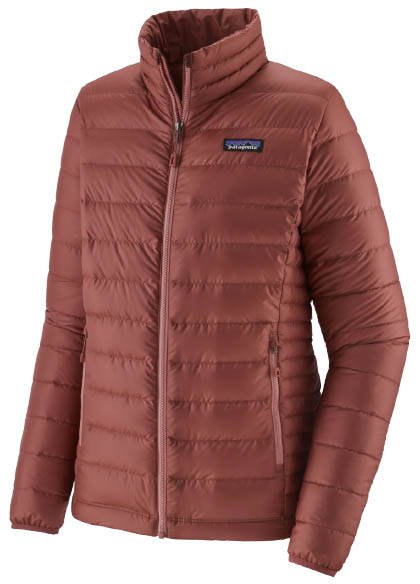 Category: Lightweight
Category: Lightweight
Weight: 12.2 oz.
Fill: 3.4 oz. of 800-fill down
What we like: Impressive versatility, good looks, and ethically sourced down.
What we don't: A bit heavy and streamlined for true performance use.
Some down jackets are unmistakably casual, while others are designed specifically for the backcountry. But if you're looking for one jacket that can do it all, the Patagonia Down Sweater is perhaps the most versatile option on the market. Like some of the more specialized picks below, the Down Sweater is light enough to pack on your next hiking trip yet warm and streamlined enough to layer under a shell for skiing. And with that premium Patagonia build quality and finish, the Down Sweater doesn't look overly technical for walking around town or grabbing a drink after a long day in the mountains.
Even though the Down Sweater is a jack of all trades, it does have some limitations. It's far from the lightest option on this list (ounce counters should see the more performance-focused Arc'teryx Cerium LT and Mountain Hardwear Ghost Whisperer/2 below), and the fit is shorter and a bit boxier than more performance-oriented models. But all in all, it's tough to go wrong with Patagonia, and it doesn't hurt that the Down Sweater is now made with 100-percent-recycled polyester and ethically sourced down. For those who want added coverage, the Down Sweater also is made in a hooded version for $50 more. And for a warmer and more performance-oriented option from Patagonia, check out the ultra-cozy Fitz Roy below.
See the Patagonia Down Sweater
Best Performance Down Jacket
2. Arc'teryx Cerium LT Hoody ($379)
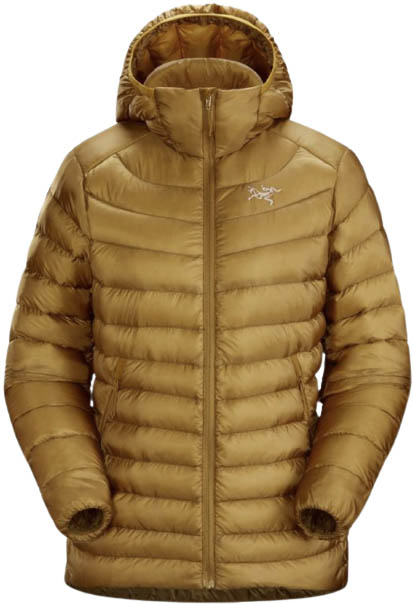 Category: Lightweight
Category: Lightweight
Weight: 9.9 oz.
Fill: 3.35 oz. 850-fill down & 80/100g Coreloft
What we like: Great warmth and weather protection in a sub-10-ounce package.
What we don't: Expensive and not super durable.
Simply put, Arc'teryx jackets are in a league of their own. They generally cost the most, look the best (Patagonia is a close competitor), and perform well enough for serious mountain athletes to put them through the wringer on a consistent basis. The Cerium LT Hoody is the company's leading lightweight down jacket and one sleek piece of gear. With a total weight of 9.9 ounces, a nearly complete feature set, and a silky interior and exterior, the Cerium LT plays and looks the part. The most direct competitor is the Feathered Friends Eos below, which has similar specs and quality but lacks the everyday appeal of the Arc'teryx here.
An interesting feature of the Cerium LT is the use of Down Composite Mapping. Arc'teryx added a limited amount of Coreloft synthetic insulation in the areas most prone to getting wet: the shoulders, underarms, cuffs, and collar. The rest of the jacket is premium down in places that need maximum heating efficiency: the core, hood, and upper arms. All in all, for the rigors of backpacking, climbing, and backcountry skiing, the Cerium LT's balance of lightweight warmth and wet-weather functionality is hard to beat. And for a popular alternative that's slightly warmer and more durable (for a considerable weight penalty), check out the Thorium AR Hoody below.
See the Arc'teryx Cerium LT Hoody
Best Budget Down Jacket
3. REI Co-op 650 Down Jacket 2.0 ($100)
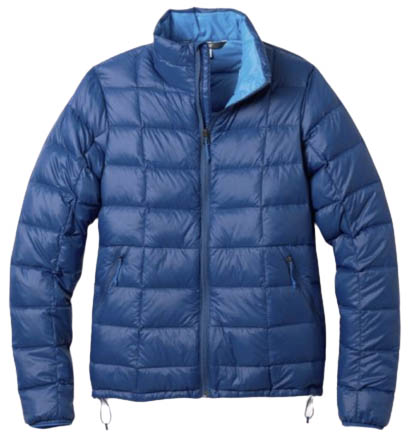 Category: Lightweight
Category: Lightweight
Weight: 10.8 oz.
Fill: 3.3 oz. of 650-fill down
What we like: Considerably cheaper than any other jacket on this list, yet surprisingly well built.
What we don't: Not warm enough for true winter use.
The majority of down jackets on this list hover between $2o0 and $400, but REI's 650 2.0 costs of fraction of that at just $100 (and often less on sale). And despite the low price point, it's still a well-rounded piece with 3.3 ounces of 650-fill down and a reasonably light weight. We also like the stylish box-like baffling, thoughtful colorways, roomy/casual cut, and more technical features like interior dump pockets and a hem cinch. All told, it's a great budget choice for everything from daily use to hiking and resort skiing.
Keep in mind that although the REI 650 Down Jacket 2.0 stuffs into its hand pocket, the 650-fill-power isn't as lofty or compressible as more premium models on this list that hit 800-fill power or higher. Because of this, the REI suffers in the warmth-to-weight department compared to the pricier options here (for example, the Arc'teryx Cerium LT above is much warmer at a lower weight). Further, REI doesn't offer the jacket in a hooded version for women (for an affordable hooded design, check out the Co-op's Stratocloud below). But like the Patagonia above, the 650 uses recycled nylon in the shell and RDS-certified down, which adds to overall appeal. For a functional down jacket at a great price, the REI 650 Down Jacket 2.0 is tough to beat.
See the REI Co-op 650 Down Jacket 2.0
Best Everyday Down Parka
4. Patagonia Down With It Parka ($299)
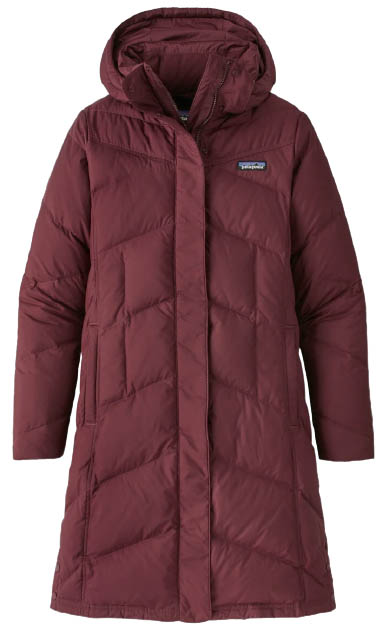 Category: Midweight
Category: Midweight
Weight: 2 lbs. 5.8 oz.
Fill: 8.3 oz. of 600-fill down
What we like: Great styling and a major boost in warmth over shorter down jackets.
What we don't: Not everyone will like the length.
Down is the best insulator for weight-conscious mountain activities, but it's also an ideal way to stay warm around town. For a high-quality option that doesn't skimp on style, the Patagonia Down With It is our favorite women's down parka for winter 2022. You get a healthy 8.3 ounces of 600-fill down, a DWR finish for repelling light moisture, and cozy features like a fleece-lined collar and pockets. Further, the Down With It earns major style points with its chevron baffles and princess seams, and a pair of snaps along each side ensure you can wear it while seated without pesky bunching (most parkas don't have this feature, and it's a good one).
The big difference between the Down With It Parka and the options above is the length, and not everyone will want the knee-length coverage and bulk. Some parkas, like Marmot's Montreal below, are classified as thigh-length rather than knee-length, but the added inches here are especially nice in cold climates like the Midwest or Northeast. And while the Down With It doesn't compress well for travel, it's got one big thing going for it: warmth. 600-fill isn't as light and compressible as higher-fill-power down, but this is less of a concern for casual use and 8.3 ounces is a generous supply. And for warmer conditions, the Down With It is available in a hip-length version, which packs in 7.1 ounces of 600-fill down and is affordably priced at $199...Read in-depth review
See the Patagonia Down With It Parka
Best Heavyweight Down Jacket
5. Rab Neutrino Pro ($375)
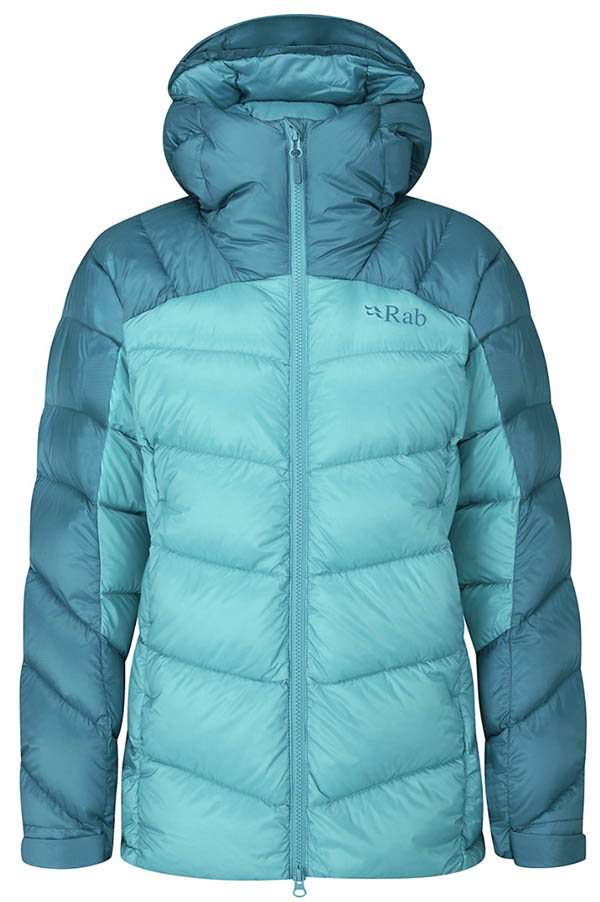 Category: Heavyweight
Category: Heavyweight
Weight: 1 lb. 2.7 oz.
Fill: 7 oz. of 800-fill down
What we like: Loaded with premium down.
What we don't: Heavy and the left-hand zip can take some getting used to.
U.K.-based Rab is among our favorite outdoor clothing brands, and the Neutrino Pro is their beloved down jacket for cold-weather climbing and mountaineering. Updated last year, the jacket now sports a water-resistant Pertex Quantum Pro shell but retains everything else that made it a classic. Most importantly, it packs in a ton of down—7 ounces of 800-fill hydrophobic down, to be exact—at roughly the same price as less-insulative options from Arc'teryx, Patagonia, and Mountain Hardwear. Further, the 20-denier shell has a quality feel and offers surprisingly good abrasion resistance. Even at $375, that's a lot of bang for your buck.
What are the downsides of the Neutrino Pro? The first is the total weight at 1 pound 2.7 ounces, which is reasonable for serious winter use but too heavy for shoulder-season conditions. Second, Americans may have problems with the European-style left-hand zipper, which can take a while to get used to. Finally, the Neutrino Pro is overkill for all but the coldest days and therefore isn't as versatile as a midweight option like the Arc'teryx Thorium AR below. These issues aside, the Rab is an exceptionally warm and comfortable winter piece at a good price.
See the Rab Neutrino Pro
Best of the Rest
6. Mountain Hardwear Ghost Whisperer/2 Hoody ($325)
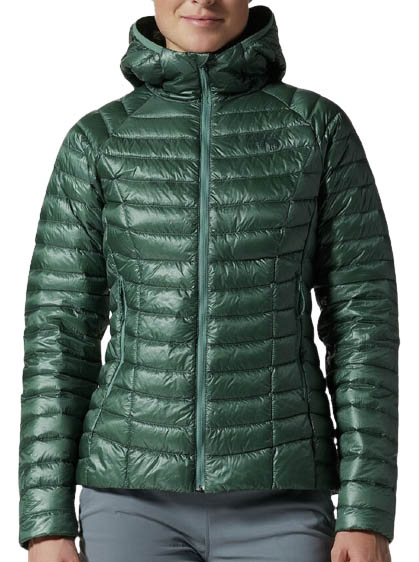 Category: Ultralight
Category: Ultralight
Weight: 7.8 oz.
Fill: 2.5 oz. of 800-fill down
What we like: The best warmth-to-weight ratio on this list.
What we don't: Superlight build isn't all that warm or durable.
For backcountry missions when every ounce counts, you'll need a jacket that offers big warmth for a low weight. Enter the 7.8-ounce Mountain Hardwear Ghost Whisperer/2, one of the most impressive jackets in its class. You get 2.5 ounces of premium 800-fill hydrophobic down in a package that stuffs down smaller than a 1-liter Nalgene (complete with a carabiner clip loop). Impressively, despite the low weight and small packed size, the Ghost Whisperer/2 doesn't compromise much on functionality or features with zippered hand pockets, a hem adjustment, and decent wind and water resistance.
However, while the Ghost Whisperer/2 is built to resist a light chill at the belay or during a summer evening at camp, it's notably less insulated than most other options here (when you factor in the difference in fill power, it's approximately as warm as the REI 650 2.0 above). And although the Ghost Whisperer/2 did get a slight durability boost in the latest update from a 7-denier shell to 10-denier, we still don't recommend this jacket as your daily driver. Finally, some might find themselves wishing for a helmet-compatible hood or a tighter seal at the wrists, but these are the sacrifices many are willing to make in the name of saving weight. And for the most diehard of ounce counters, Mountain Hardwear now makes the Ghost Whisperer UL Hoody, which features a 5-denier shell, 1,000-fill down, and clocks in at only 6.2 ounces.
See the Mountain Hardwear Ghost Whisperer/2 Hoody
7. Outdoor Research Coldfront Down Hoodie ($229)
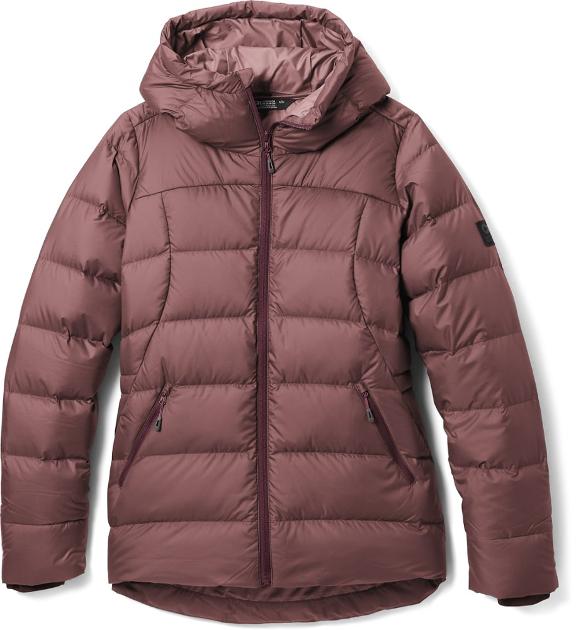 Category: Midweight
Category: Midweight
Weight: 1 lb. 5.2 oz.
Fill: 6.3 oz. of 700-fill-power down & 150g VerticalX ECO
What we like: Comfy, classy, and well-priced for what you get.
What we don't: Doesn't pack down nearly as small as more premium options.
Outdoor Research is known for producing quality gear that consistently undercuts the competition in price, and their new Coldfront Down Hoodie is no exception. At $229, it's considerably cheaper than the more premium options on this list but doesn't fall too far behind in terms of performance. In testing the Coldfront, we were immediately impressed by the lofty and cozy build that uses a mix of 700-fill down and weather-ready VerticalX Eco synthetic insulation at the shoulders and cuffs. We also love the soft-yet-rugged shell and nice touches like fleece-lined handwarmer pockets, snug-fitting cuff gaiters with thumb loops, and classy branding on the sleeve. For everyday use and casual winter adventuring, the Coldfront is a very well-rounded option.
How does the OR Coldfront stack up to the picks above? It's warmer than lightweight options like the Patagonia Down Sweater and Arc'teryx Cerium LT but falls short of a heavyweight like Rab's Neutrino Pro for truly frigid conditions. It's also on the heavier side for performance use and lacks the Rab's weather-ready shell and hydrophobic down, which go a long way in boosting protection on particularly wet adventures. Finally, the Coldfront doesn't pack down as small as the higher-fill-power options above and below, but considering the price and warmth, it's all most women need in a down jacket. For warmer and longer options from OR with a similar mix of down and synthetic insulation, check out their new Coze Down collection, including the $299 coat and $349 parka.
See the Outdoor Research Coldfront Down Hoodie
8. Marmot Montreal Down Coat ($285)
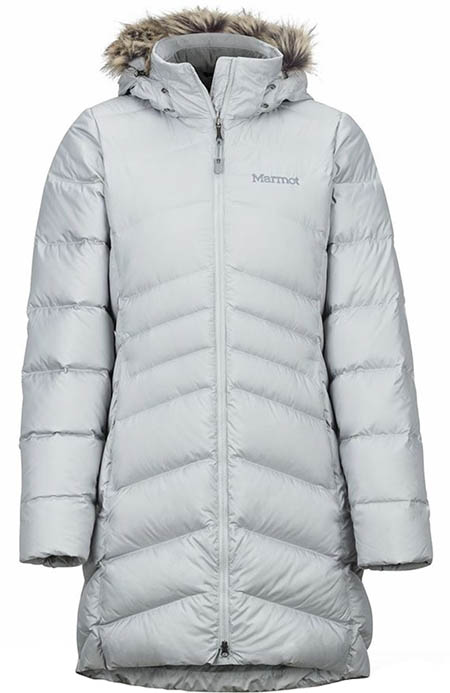 Category:Midweight
Category:Midweight
Weight: 2 lbs. 2.2 oz.
Fill: 7.1 oz. of 700-fill down
What we like: Mid-thigh length and soft liner.
What we don't:Fits small and some might prefer a longer cut.
Casual down jackets come in all shapes and sizes, but we love the extra warmth and coverage that a parka provides. Marmot's Montreal checks all of the important boxes with 700-fill down, good freedom of movement, and a super cozy hood with a removable faux fur liner. The inside of the jacket has a fleece liner that is noticeably soft to the touch, and the outside has a DWR treatment to help with light precipitation. Add in clean lines and some classy colorways, and the Montreal is a great all-around parka for the cold at a reasonable price point.
Keep in mind that the Marmot Montreal's thigh-length cut is a little shorter than competitors like the Patagonia Down With It Parka, which translates to less protection and warmth (but a more playful style). And in our experience, the Montreal is slightly less insulated and not suited for temperatures much below freezing without layers underneath. In terms of the all-important fit factor, we found that the jacket runs slightly small and would recommend sizing up if you're in between sizes or plan on layering. But if you can get the fit dialed, the Montreal is a winner...Read in-depth review
See the Marmot Montreal Down Coat
9. Mountain Hardwear Stretchdown Hoody ($275)
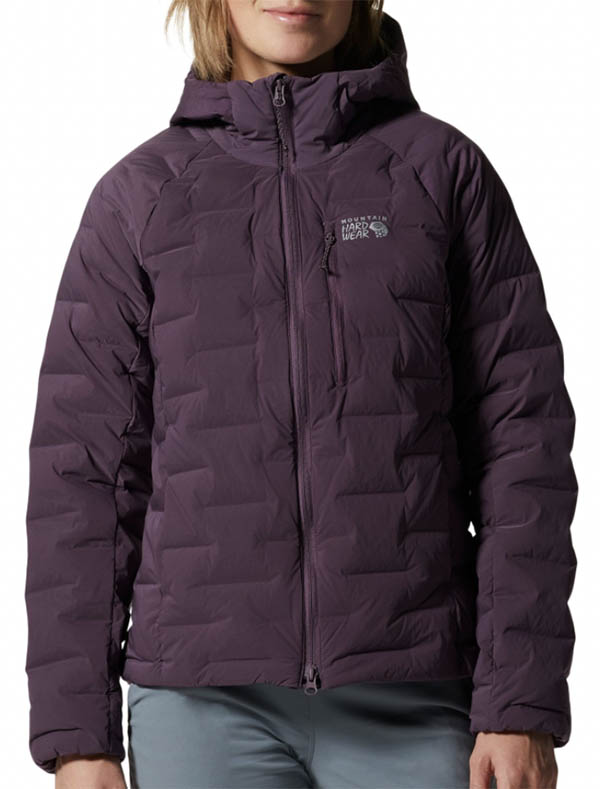 Category: Lightweight
Category: Lightweight
Weight: 15.5 oz.
Fill: 3.3 oz. of 700-fill down
What we like: Similar styling and comfort as the Rab Cubit below in a lighter package.
What we don't: Not equipped for wet weather and shorter cut than much of the competition.
Mountain Hardwear launched its Stretchdown line a handful of years ago, epitomized by soft and stretchy shells and welded seams (rather than stitched baffles). The goal here was to combine the insulation of down with the range of motion, durability, and comfort of a softshell—and we'd say Mountain Hardwear pulled it off pretty well. The jacket's knit fabric is very tough, and the stretchiness gives it a plush feel that you typically don't get from a down piece. Tack on some clean styling—even the logo is understated—and the Stretchdown is a practical and good-looking jacket for everyday use.
But the performance chops of the Stretchdown are limited: The 700-fill-power down has less loft than the true backcountry pieces on this list, and the jacket is bulky and heavy for the amount of warmth you get. Further, $275 is no small price for a casual item (you can save with the REI 650 above or Stratocloud below), and some will appreciate the even more casual appearance of the Patagonia Silent Down (below). Finally, we have noticed that the Stretchdown's fabric has a tendency to hold stains, and the elastic in our cuffs has grown tired over time. But we have a soft spot for this jacket (no pun intended), which receives compliments almost every time we go out. It's also worth noting that Mountain Hardwear offers a number of versions of the Stretchdown, including a heavyweight parka, which has become one of our tester's go-to jackets for everyday winter use.
See the Mountain Hardwear Stretchdown Hoody
10. REI Co-op Stratocloud Down Hoodie ($189)
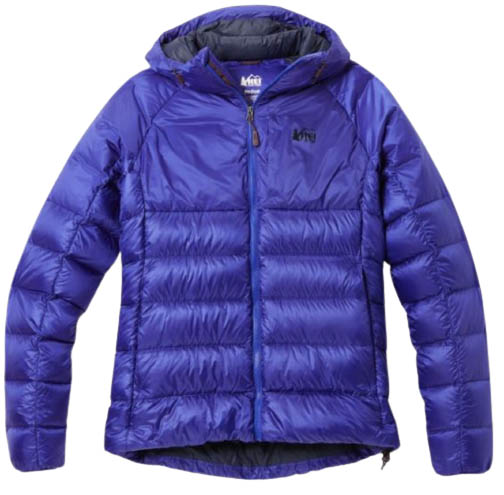 Category: Lightweight
Category: Lightweight
Weight: 15.8 oz.
Fill: 5.9 oz. of 600-fill down
What we like: Good overall warmth and weather protection for much less than the competition.
What we don't: Low-quality down and heavier than most midweight jackets.
REI's 650 Down 2.0 above is our top budget pick at just $100, but the Stratocloud here is arguably the better value, packing in an impressive amount of performance for just $189. First off, you get 5.9 ounces of 600-fill down (certified by the Responsible Down Standard), placing it on par for warmth with many of the midweight jackets here. In terms of weather protection, the Stratocloud features a Pertex shell with durable water repellent finish, which is enough to fend off light rain or drips from above. To top it all off, the jacket has a premium feel reminiscent of pricier down jackets, with a full suite of storage (including interior dump pockets) and adjustments.
But while the Stratocloud holds strong with other jackets in terms of warmth, weather protection, and features, where it lags behind is in weight and packability. Checking in at 15.8 ounces and stuffing down to the size of a loaf of bread, it's heavier and bulkier than jackets like the Patagonia Fitz Roy and Rab Microlight Alpine below, both of which are arguably warmer with higher quality down fill. Second, the REI's hood is not helmet compatible, taking it out of the running for some climbers and skiers. But we're getting into the nitty gritty with these critiques, and most of us aren't too deterred by the addition of a few ounces—especially when they're accompanied by hundreds of dollars of savings. Added up, the Stratocloud is an impressive jacket for considerably less than the competition, making it one of the best values here.
See the REI Co-op Stratocloud Down Hoodie
11. The North Face Gotham ($230)
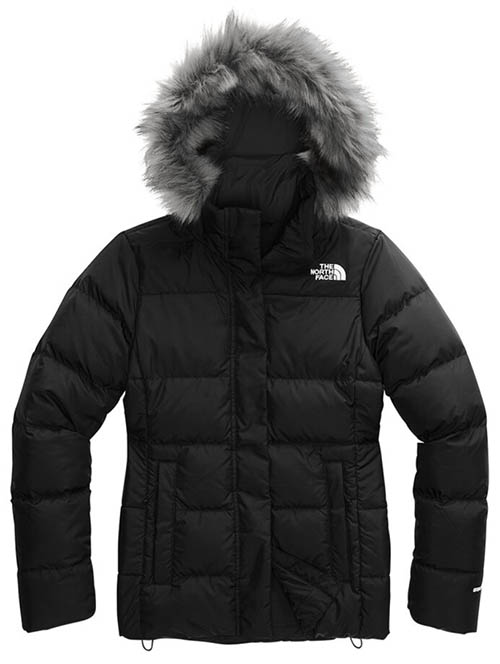 Category: Midweight
Category: Midweight
Weight: 1 lb. 13.2 oz.
Fill: 550-fill down & 150g Heatseeker
What we like: Good warmth and durability in a streamlined package.
What we don't: Decidedly casual.
If you speak the language of fur-brimmed hoods and attractive colorways more than warmth-to-weight ratios and fill power, The North Face's Gotham jacket is worth a look. Stuffed with 550-fill down and tipping the scales at a hefty 1 pound 13.2 ounces, the Gotham doesn't hold a candle to many of the lighter, more performance-focused jackets here, but it's not trying to either. Instead, the Gotham fills a nice niche for women who want the warmth and comfort of a down puffy without the techy appearance or specialized features.
The Gotham has a lot going for it when it comes to day-in, day-out use. First is the 50-denier fabric, which is considerably more robust than much of the competition. Second, the jacket incorporates both down and synthetic insulation, which keeps the cost low and adds extra protection against light rain and snow. Finally, the Gotham comes with thoughtful features like an internal media pocket and adjustable hood with a removable faux-fur brim (it's also available in a parka length for just $20 more). As an everyday down jacket that will hold up throughout multiple winters of use, the Gotham is a well-loved option at an affordable price point, and past-season models can often be found on sale.
See the North Face Gotham
12. Arc'teryx Thorium AR Hoody ($325)
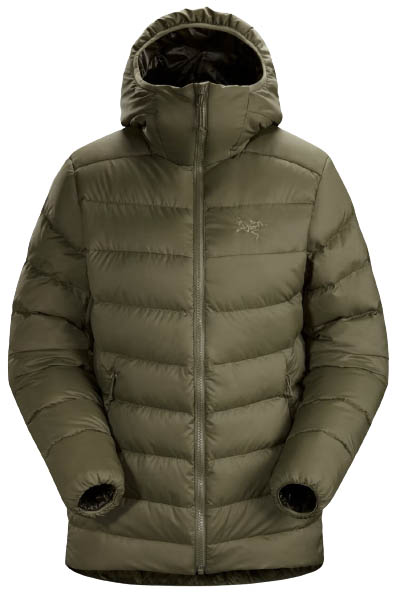 Category: Lightweight
Category: Lightweight
Weight: 14.8 oz.
Fill: 3.7 oz. of 750-fill down
What we like: Do-everything personality.
What we don't: Expensive despite having less premium down.
While Arc'teryx's Cerium series shaves weight and features for technical pursuits, their Thorium collection places a bigger premium on everyday functionality. With the Thorium AR, you get more warmth than the Cerium LT above, along with a considerable boost in durability and wind resistance (30D vs. 10D)—all at a savings of $54. Further, its regular fit (vs. the Cerium's trim fit) gives you ample room for layering underneath while still being streamlined enough to wear as a midlayer or classy standalone piece. All in all, the Thorium AR is one of the most well-rounded jackets here and it's hard to argue with Arc'teryx top notch build quality, too.
Despite its "all round" designation (hence the AR), the Thorium is no slouch in the performance department. You get 3.7 ounces of 750-fill down (it's not ultra-premium, but 750 is still pretty good) in a sub-1-pound package, along with synthetic insulation in areas most prone to getting wet: along the hood, cuffs, and under the arms. The price point is decidedly high for most casual users, but the Thorium AR's premium materials and construction will last you season after season. As always, we appreciate the sleek look and impressive quality of Arc'teryx products, which is why two of their down jackets made our list… Read in-depth review
See the Arc'teryx Thorium AR Hoody
13. Patagonia Silent Down Jacket ($249)
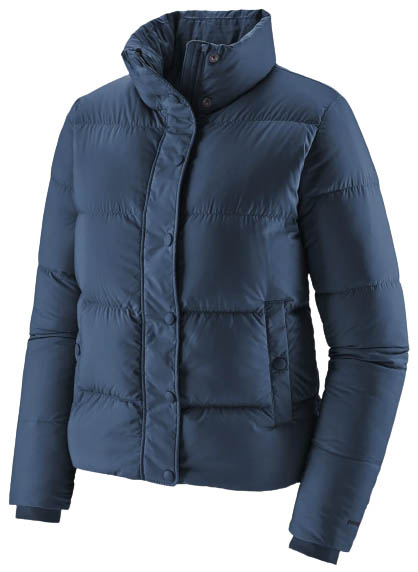 Category: Lightweight
Category: Lightweight
Weight: 1 lb. 4.1 oz.
Fill: 3.7 oz. of 700-fill down
What we like: Stylish design and a comfortable and supple shell fabric.
What we don't: Lacks versatility for performance use and not warm enough for true winter conditions.
It's no secret that we love Patagonia's down jackets—their all-arounder Down Sweater is our top pick, and the midweight Fitz Roy has been one of our favorite belay jackets for years running. Not only is Patagonia's fit and finish at or near the top of the market, but we're also big fans of their sustainable practices and ethically sourced materials. And the Silent Down Jacket here is no exception, combining an eye-catching casual design and sleeping-bag-like comfort with recycled materials throughout.
To be sure, the Silent Down is not a performance piece—like the TNF Gotham and Marmot Montreal above, this is an everyday jacket for in-town use. The stylish metal-snap closure, large baffles, stand-up collar, and subtle colorways offer a great look, but the true selling point (at least for us) is the soft and stretchy shell fabric that give the jacket its name. And the Silent Down holds its own in terms of performance too, with a durable 40-denier weave and 3.7 ounces of down fill for ample insulation against a shoulder season or mild winter chill. For activities like hiking and skiing you'll want to look elsewhere, but the Silent Down is a solid daily driver—and now it comes in an extra-long (44.5 in.) parka-length version, too, which goes head to head with a jacket like the OR Coze Down Parka below.
See the Patagonia Silent Down Jacket
14. Feathered Friends Eos ($389)
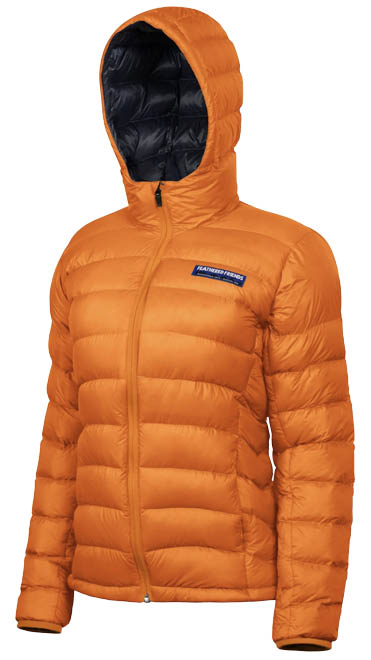 Category: Light/ultralight
Category: Light/ultralight
Weight: 9 oz.
Fill: 2.8 oz. of 900-fill down
What we like: Premium build quality and superb warmth-to-weight ratio.
What we don't: Technical appearance and occasional issues with availability.
Most of the brands here design and produce full lineups of outerwear, ranging from hardshells to hiking pants and more. But not Feathered Friends. As their name implies, just about every product made by this Seattle-based company is stuffed with high-quality down, from sleeping bags and insulated pants to jackets and bedding. As true down specialists, Feathered Friends' jackets stand out from the rest for their quality craftsmanship, ethically sourced materials, and high performance for serious outdoors people.
With that in mind, it comes as little surprise that the Feathered Friends Eos is one of the leading technical down jackets for women on the market. The Eos packs 2.8 ounces of 900-fill goose down (one of the most premium fill powers here) into a sub 10-ounce package—a very impressive amount of warmth for the weight. You do pay a bit of a premium at $389 (price recently jumped $50), and it certainly doesn't have as much daily appeal as the Down Sweater or Cerium LT above, with a non-adjustable hood, limited color options, and overall technical appearance. But for lightweight warmth in a premium package, the Eos is a great match for serious adventurers. Of note: you can expect an update to the Eos by the end of the year, including a new chest pocket and drawstring hood...Read in-depth review
See the Feathered Friends Eos
15. Patagonia Fitz Roy Down Hoody ($399)
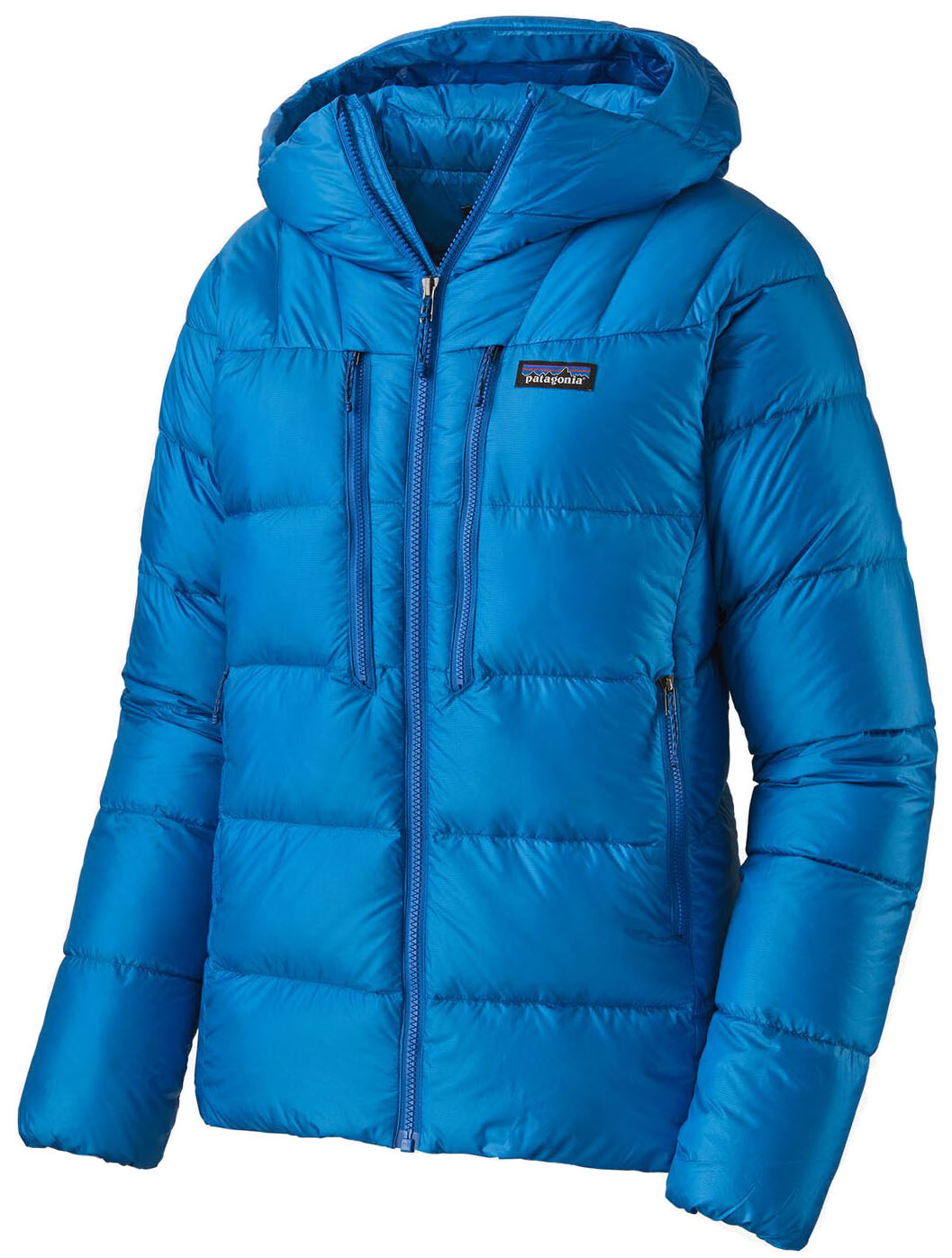 Category: Midweight
Category: Midweight
Weight: 14.8 oz.
Fill: 4.5 oz. of 800-fill down
What we like: Sleeping bag-like loft and coziness.
What we don't: More expensive and less versatile than the Rab Microlight Alpine.
For a step up in warmth from the Patagonia Down Sweater, the Fitz Roy Down Hoody is built for cold weather and technical use. In this case, you get 4.5 ounces of 800-fill down (the Down Sweater has 3.5 oz.), along with a Pertex Quantum shell for excellent wind protection. With lightweight materials and Patagonia's high-quality construction, the result is one of the best warmth-to-weight ratios here and an ideal insulator for speedy winter missions when every ounce counts. And with soft fabrics and a fashionable fit and finish, the Fitz Roy is the kind of jacket you'll put on and never want to take off.
Patagonia updated the Fitz Roy a couple seasons ago, with changes including a 5-ounce-lighter weight, noticeably less down (4.5 oz. compared to the previous version's 6.4), and a slightly shorter hem. The Fitz Roy Hoody (the previous model was the Parka) now falls into the midweight category, similar to the Rab Microlight Alpine below. The Rab can't compete with the Fitz Roy's coziness, but it wins out in both weather protection and durability, with hydrophobic down and a 30-denier Pertex Quantum shell (we've found the Fitz Roy's 20D shell to be pretty fragile). But with higher-quality down, the Patagonia is slightly warmer, and some will appreciate the high-loft style (although unlike the Rab, the Fitz Roy is too bulky to be worn as a midlayer). And for those looking to save, Marmot's $100-cheaper Hype Down Hooded Jacket boasts the same fill weight and fill power as the Fitz Roy, but in a heavier and less premium package...Read in-depth review
See the Patagonia Fitz Roy Down Hoody
16. Rab Cubit Stretch Down Hoody ($300)
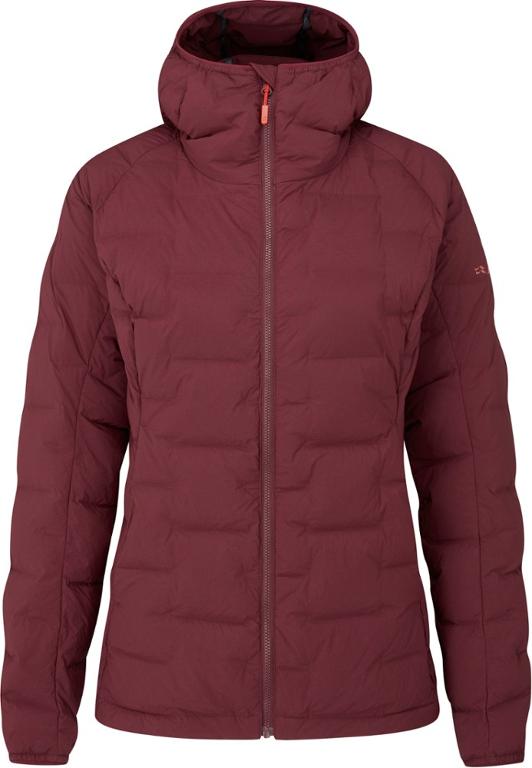 Category: Midweight
Category: Midweight
Weight: 1 lb. 1.1 oz.
Fill: 5.3 oz. of 700-fill-power down
What we like: Warm, stylish, and a real standout in terms of comfort.
What we don't: Pricey and falls short of true performance pieces in weight and packability.
Stretch-woven shells are a new trend in down jackets, and Rab recently threw their hat into the ring with the Cubit Stretch Down Hoody. Like the Mountain Hardwear Stretchdown above, the Cubit features a soft and pliable shell by way of Pertex's 3D Weave Technology, along with welded baffles to keep insulation in place without the need for stitches. And it ups the ante in terms of warmth, with 5.3 ounces of 700-fill down compared to the Stretchdown's 3.3 ounces. In fact, the first time we put on the Cubit, we were struck by its loft, which felt on par with a jacket like the Patagonia Fitz Roy above. And as we've come to expect from Rab, build quality is excellent with a high attention to detail.
A strong argument can be made for the Cubit over the Stretchdown. You get more technical features with the Rab, including a weather-resistant Pertex shell with durable water repellent finish, hydrophobic down, and more warmth for less weight overall. The two jackets' shortcomings are similar: The Cubit's bulk and heft take it out of the running for weight-conscious missions (we still love it for cragging), and $300 is expensive for a casual down jacket. But while we've found the quality of Rab's outerwear to be superior to that of Mountain Hardwear, the Stretchdown's design and colorway options are particularly eye-catching, which is what most look for in an everyday piece. Comparisons aside, the Rab is a warm, comfortable, and durable down jacket, great for use around town and casual backcountry outings. For added warmth and coverage, it's also available in a classy parka-length variation for an additional $25...Read in-depth review
See the Rab Cubit Stretch Down Hoody
17. Outdoor Research Coze Down Parka ($349)
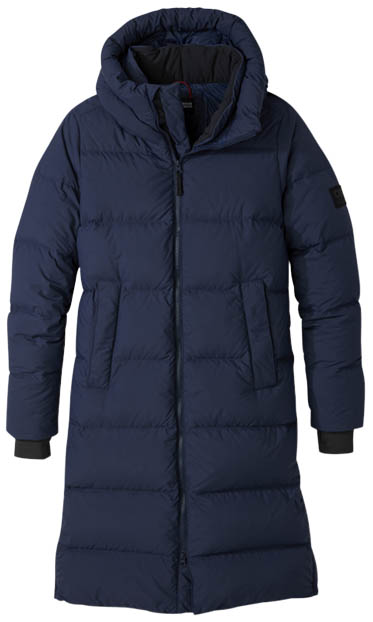 Category: Heavyweight
Category: Heavyweight
Weight: 2 lbs. 3.5 oz.
Fill: 8.3 oz. of 700-fill-power down
What we like: A true knee-length parka with a durable woven shell.
What we don't: Expensive and sizing can be tricky.
We often turn to Outdoor Research for reasonably priced technical outerwear, but the Seattle-based company has gone fully casual with the Coze Down Parka here. And we like what they've done, combining high-quality materials with an elegant urban style. The knee-length Coze is by far the longest parka on this list, touting a 43-inch center back length that's a full 10 inches longer than a jacket like the Marmot Montreal above. On top of that, you get a soft and durable 70x90-denier plain weave shell—great for withstanding the rigors of city use—and side zips that make it easy to sit, bike, or drive.
There are a lot of reasons you might want the extra coverage of the Coze, especially in particularly frigid winter climates. For one, the length eliminates the need for insulated pants on quick jaunts around the block. Second, you're ensured insulation under you while sitting, which you don't always get with a parka-length jacket. And finally, the style is undeniably classy, whether you're walking the dog or going out on a Saturday night. Sizing can be tricky—we recommend finding a way to try on the Coze or purchasing from an online retailer with a good return policy—and unlike many parkas, you don't get a cinch at the waist. But for top-notch coverage from a trusted brand, the Coze is an attractive option.
See the Outdoor Research Coze Down Parka
18. Fjallraven Expedition Pack Down Hoodie ($250)
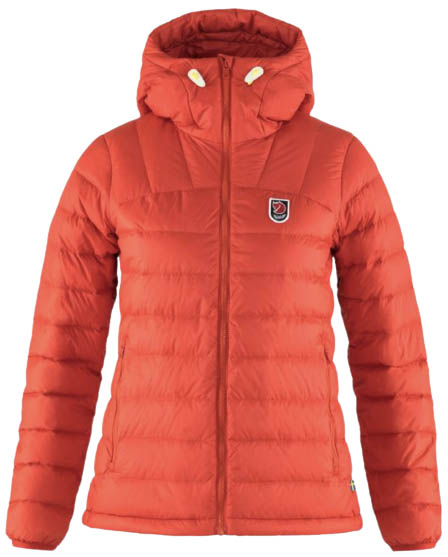 Category: Lightweight
Category: Lightweight
Weight: 15.3 oz.
Fill: 3.5 oz. of 700-fill down
What we like: A technical down jacket with classy Scandinavian styling.
What we don't: Expensive and not as warm or light as other options here.
Style and technical performance don't always go hand in hand, but Fjallraven manages to merge the two better than most. On paper, their Expedition Pack Down Hoody looks a lot like many other jackets here: you get 3.5 ounces of 700-fill down and horizontal baffling in a sub-1-pound build that packs nicely into its own pocket. But the devil is in the details here: the Expedition boasts a layer of synthetic insulation over the shoulders for added protection against moisture, and contrasting pullcords and leather tabs at the collar and a classy logo patch on the chest add a nice dose of flair. For days that start at the trailhead and end at the brewery, the Fjallraven is a versatile and standout piece.
We're used to paying a pretty penny for all things Fjallraven, so it surprised us to see the Expedition priced relatively affordably at $275. But compared to our top-ranked Down Sweater, the added $46 is difficult to justify: the Patagonia is warmer and lighter with a similar overall fit and finish (although it lacks the cool Scandinavian styling of the Fjallraven). Alternatively, Cotopaxi's Fuego is another option that nicely balances around-town-friendly looks and performance, with a distinctive casual appearance, higher-quality down, and a lower price point. All that said, these are minor nitpicks if you like Fjallraven's styling (we do), and it's hard to argue with the Expedition's premium all-around design.
See the Fjallraven Expedition Pack Down Hoodie
19. Rab Microlight Alpine ($280)
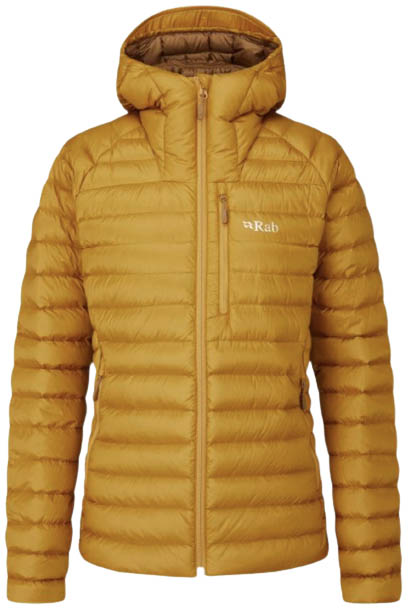 Category: Midweight
Category: Midweight
Weight: 14.6 oz.
Fill: 5.1 oz. of 700-fill down
What we like: Warm for the price; water-resistant build.
What we don't: Not as much daily appeal as the Patagonia Down Sweater.
Like the heavyweight Neutrino Pro above, Rab's popular Microlight Alpine Jacket pays tribute to the brand's climbing heritage. To start, it's built to handle wind and light moisture thanks to a tough Pertex Quantum shell, DWR coating, and hydrophobic down. Further, the rigid structure of the jacket's brimmed hood has a hardshell-like feel, offering great all-around coverage and protection. You'll still want to don a waterproof layer if the skies open up, but the Microlight Alpine stands out as one of the more weather-ready midweight down jackets we've tested.
Packing 5.1 ounces of 700-fill-power down in a women's medium (size 12), the Rab is warmer than competitors like Patagonia's Down Sweater Hoody (3.5 oz. of 800-fill down) and Feathered Friends' Eos (2.8 oz. of 900-fill down). But like the Eos, it can't match the Patagonia in terms of everyday appeal. The jacket's slim fit means you can't layer much underneath, and the European-style left-hand zipper takes some getting used to. Finally, it's on the heavy side for hauling in a pack at 14.6 ounces, but that extra weight does come with a boost in insulation. Overall, we think the Rab's combination of warmth, weather resistance, and reasonable $280 price make it a well-rounded backcountry piece...Read in-depth review
See the Rab Microlight Alpine
20. Cotopaxi Fuego Hooded ($275)
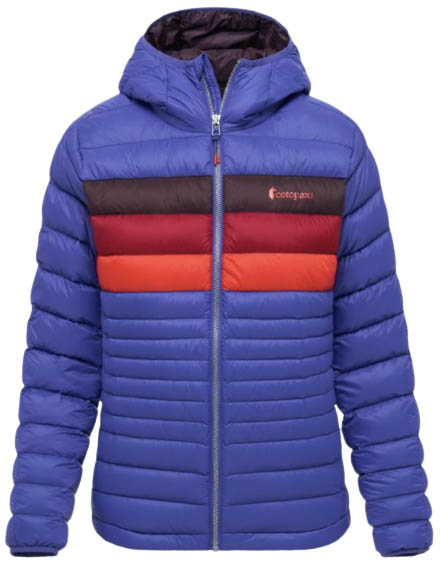 Category: Lightweight
Category: Lightweight
Weight: 14 oz.
Fill: 800-fill-power down
What we like: Retro styling with premium down fill.
What we don't: Not a lot of subtle color options, no fill weight provided, and not the softest hand feel.
There's no shortage of down jackets to choose from, but the Cotopaxi Fuego stands out with its fun, retro styling. Featuring premium 800-fill down and a versatile 20-denier shell that is reasonably tough yet lightweight, the Fuego is well-built and capable despite its clear casual intentions. Of course, the retro styling is its calling card, and the Fuego is currently offered in 10 fun colorways, all but one with the signature multi-colored baffles across the torso. Throw in responsibly sourced down and the fact that Cotopaxi is a certified B Corp, and the Fuego is an easy jacket to get behind.
In terms of competitors, Patagonia's Down Sweater Hoody uses the same 800-fill-power down and has a slightly thicker 20 x 30-denier shell but is 1 ounce heavier and costs $279 (without the Cotopaxi's fill weight, it's difficult to precisely nail down which is the warmer jacket). In other words, the Fuego offers performance practically on par with our number one pick, but for $29 less and with a few extra style points (it's noteworthy that Patagonia recently added two striped colorways to their Down Sweater lineup). The most discernible difference is material quality: the men's Fuego that we tested had a noticeably plasticky and slippery feel compared to the smooth and cozy Patagonia. But the Cotopaxi Fuego hits a nice balance of performance chops, casual appeal, and value, which is why it's included here.
See the Cotopaxi Fuego Hooded
21. Outdoor Research Helium Down Hoodie ($279)
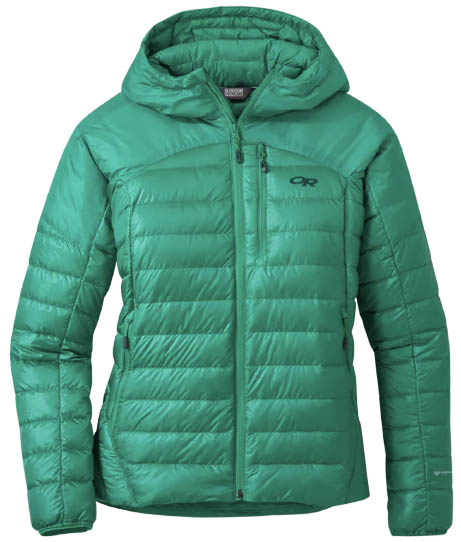 Category: Lightweight
Category: Lightweight
Weight: 15.4 oz.
Fill: 3.2 oz. of800-fill down
What we like: Waterproof fabric on the hood and shoulders; particularly abrasion resistant.
What we don't: Shell is fairly crinkly; heavy for a performance-oriented jacket.
For all their inherent strengths, down jackets aren't perfect: namely, they perform poorly in wet weather and their thin fabrics are often lacking in durability. But with the Helium Down Hoodie, Outdoor Research addresses both of these concerns in one fell swoop. The Helium uses Pertex's Diamond Fuse technology throughout the shell, which improves abrasion resistance without adding weight. On top of that, you get waterproof Pertex Shield on the hood and shoulders—the same fabric used in OR's popular Helium rain jacket—for protection from rain and melting snow. The result is a sub-1-pound down jacket that is both impressively durable and relatively capable in wet weather.
But while the Helium Down's partially waterproof shell is a nice touch, you won't find us relying on it for much more than a light rain or snow. In terms of the competition, the Cerium LT above is significantly lighter, and the use of synthetic Coreloft in the hood and shoulders (which insulates even when wet) lends similar wet-weather assurance. In addition, we've found the crinkly Diamond Fuse shell makes the OR jacket a little less cozy than an alternative like the Cerium, and the jacket is known to run small for its size. Nitpicks aside, the Helium's solid weatherproofing and durability make it an intriguing standalone piece, earning it a spot on our list.
See the Outdoor Research Helium Down Hoodie
Women's Down Jacket Comparison Table
| Jacket | Price | Weight | Category | Down Fill | Denier | Packable |
|---|---|---|---|---|---|---|
| Patagonia Down Sweater | $229 | 12.2 oz. | Lightweight | 3.4 oz. of 800 fill | 20Dx30D | Chest pocket |
| Arc'teryx Cerium LT Hoody | $379 | 9.9 oz. | Lightweight | 3.4 oz. of 850 fill | 10D | Stuff sack |
| REI Co-op 650 Down Jacket 2.0 | $100 | 10.8 oz. | Lightweight | 3.3 oz. of 650 fill | Unavail. | Hand pocket |
| Patagonia Down With It Parka | $299 | 2 lbs. 5.8 oz. | Midweight | 8.3 oz. of 600 fill | 50D | No |
| Rab Neutrino Pro | $375 | 1 lb. 2.7 oz. | Heavyweight | 7 oz. of 800 fill | 20D | Stuff sack |
| MH Ghost Whisperer/2 Hoody | $325 | 7.8 oz. | Ultralight | 2.5 oz. of 800 fill | 10Dx10D | Hand pocket |
| Outdoor Research Coldfront | $229 | 1 lb. 5.2 oz. | Midweight | 6.3 oz. of 700 fill | 30D | Hand pocket |
| Marmot Montreal Down Coat | $285 | 2 lbs. 2.2 oz. | Midweight | 7.1 oz. of 700 fill | Unavail. | No |
| Mountain Hardwear Stretchdown | $275 | 15.5 oz. | Lightweight | 3.3 oz. of 700 fill | Unavail. | No |
| REI Co-op Stratocloud Hoodie | $189 | 15.8 oz. | Lightweight | 5.9 oz. of 600 fill | Unavail. | Stuff sack |
| The North Face Gotham | $230 | 1 lb. 13.2 oz. | Midweight | 550 fill | 50D | No |
| Arc'teryx Thorium AR Hoody | $325 | 14.8 oz. | Lightweight | 3.7 oz. of 750 fill | 30D | Stuff sack |
| Patagonia Silent Down Jacket | $249 | 1 lb. 4.1 oz. | Lightweight | 3.7 oz. of 700 fill | 40D | No |
| Feathered Friends Eos | $389 | 9 oz. | Light/UL | 2.8 oz. of 900 fill | 12Dx20D | Stuff sack |
| Patagonia Fitz Roy Down Hoody | $399 | 14.8 oz. | Midweight | 4.5 oz. of 800 fill | 20D | Chest pocket |
| Rab Cubit Stretch Down Hoody | $300 | 1 lb. 1.1 oz. | Midweight | 5.3 oz. of 700 fill | Unavail. | No |
| OR Coze Down Parka | $349 | 2 lbs. 3.5 oz. | Heavyweight | 8.3 oz. of 700 fill | 70Dx90D | No |
| Fjallraven Expedition Pack Down | $250 | 15.3 oz. | Lightweight | 3.5 oz. of 700 fill | Unavail. | Hand pocket |
| Rab Microlight Alpine | $280 | 14.6 oz. | Midweight | 5.1 oz. of 700 fill | 30D | Stuff sack |
| Cotopaxi Fuego Hooded | $275 | 14 oz. | Lightweight | 800 fill | Unavail. | Inner pocket |
| Outdoor Research Helium Down | $279 | 15.4 oz. | Lightweight | 3.2 oz. of 800 fill | 30D | Hand pocket |
Women's Down Jacket Buying Advice
- Performance vs. Casual Down Jackets
- Down Jacket Categories
- Warmth
- Fill Power
- Fill Weight
- Our Estimated Temperature Scale
- Weight
- Compressibility and Packed Size
- Shell Fabric and Durability
- Sustainability
- Hydrophobic Down and DWR Treatment
- Down Jacket Fit and Length
- Hood or No Hood?
- What About Synthetic Jackets?
Performance vs. Casual Down Jackets
The first step in finding the best women's down jacket is determining what your end use will be. Although many down jackets are ideal for mountain environments and outdoor activities given their lightweight and packable nature, down jackets are also our first choice for everyday warmth in the cold winter months. In our picks above, we often call out a jacket's intentions. If you're in the market for a technical piece for skiing, hiking, climbing, and other human-powered activities, look for high fill power, low weight, and features like a helmet-compatible hood and two-way zipper. These jackets will likely have thinner fabrics (read: less durability), trimmed-down feature sets, and slim fits (the Arc'teryx Cerium LT and Mountain Hardwear Ghost Whisperer/2 are prime examples). For everyday use, jackets will have thicker shell fabrics (the Gotham's shell is 50D), regular fits that are great for layering, and features like knee-length hems and fur-brimmed hoods. Casual jackets will generally use lower-quality down and weigh more, too.

Some jackets do a great job at splitting the difference, with competitive warmth-to-weight ratios but fits and finishes that transition nicely for around-town use. The entire down sweater category fits this bill, a designation that describes a traditional-looking puffy jacket with fewer performance-focused features than the technical pieces mentioned above. For example, the Patagonia Down Sweater and Cotopaxi Fuego are both great for casual wear but lightweight enough to pack for active pursuits. If you're in the market for a single down jacket that works well in almost every environment, down sweaters are a great place to start.
Down Jacket Categories
Lightweight
The lightweight down jacket category is the industry's most popular and our top choice for daily wear, travel, light adventuring, and layering for winter sports. Lightweight jackets (this category includes most down sweaters) are remarkably versatile too, and they can pull double duty as both midlayers and standalone pieces. Further, they're typically more fully featured and durable than ultralight options and are less bulky (and offer greater mobility) than their mid and heavyweight counterparts. The temperature range for lightweight jackets depends on factors like layering and exertion, but we find that they are typically suitable for approximately 35 to 50 degrees Fahrenheit (more on this in "Our Estimated Temperature Scale" below). Leading models include the Patagonia Down Sweater, REI Co-op 650 Down Jacket 2.0, and Mountain Hardwear Stretchdown Hoody.
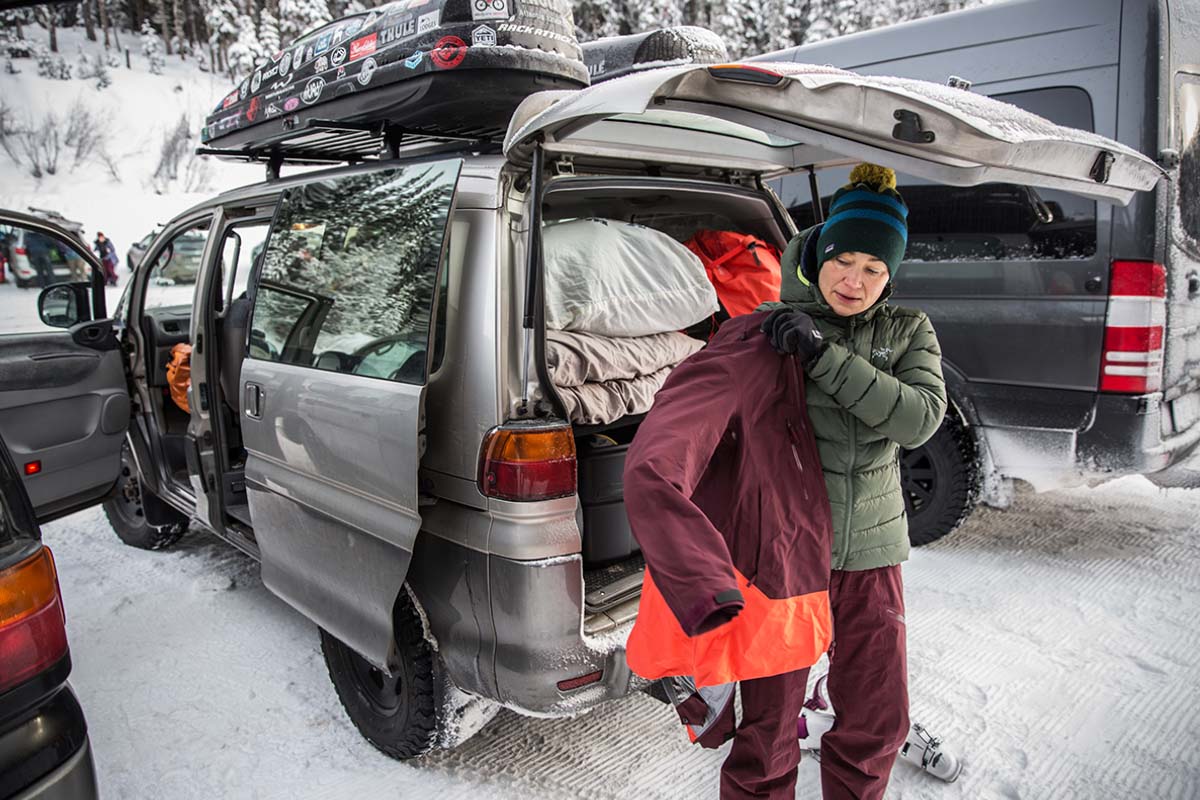
Ultralight
Ultralight down jackets are specialized pieces designed for backpacking, climbing, backcountry skiing, and other outdoor pursuits where every ounce counts. These down jackets might have similar fill weights as those in the lightweight category but are ultralight due to their use of premium down (fill power), thin shell fabrics (denier), and minimalist zippers and pockets. Interestingly, we frequently see this category of down jacket worn as daily layers around cities, including the Mountain Hardwear Ghost Whisperer/2 and Feathered Friends Eos. However, despite their high quality, we find most ultralight jackets fragile and minimalist (not to mention expensive), and thus impractical for everyday use. But for the right environment (fast-and-light pursuits), they're indispensable.
Midweight and Heavyweight
Down jackets in mid and heavyweight categories represent a significant step up in warmth from lightweight and ultralight models and are intended for serious winter conditions (regardless of if you're in the mountains or the city). Most notably, you'll see fill weight go up to 6-7 ounces or more (for instance, the Rab Neutrino Pro has 7 oz. of down). Jackets in this weight class also are far puffier than the other categories, and as a result take up quite a bit more space when stuffed down. We've included a number of our favorite mid and heavyweight options in this article, but for a more in-depth look at the market, see our article on the best winter jackets.
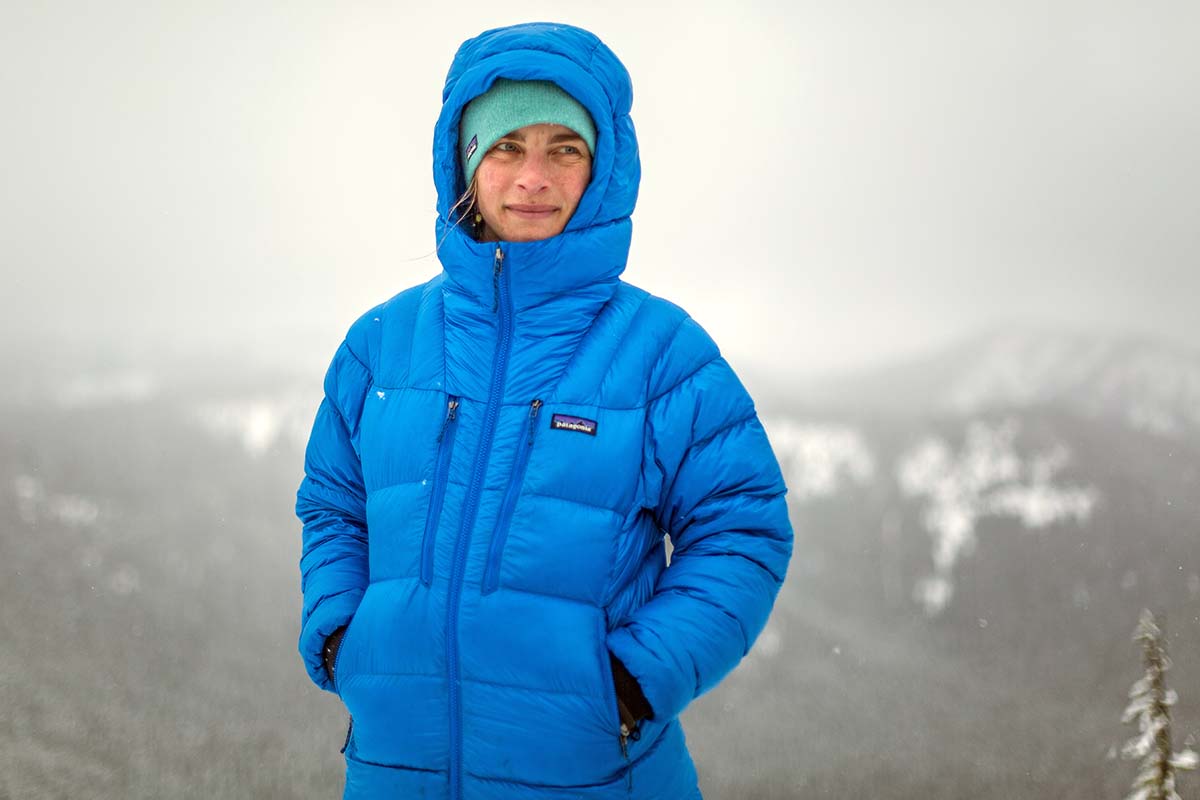
Warmth
Simply put, nothing beats the lofty and premium warmth that down provides. Down insulation functions so effectively because the loose clusters of feathers are great at trapping body heat. We'd love to have a temperature rating system to measure this warmth, but unlike sleeping bags (which are given an official EN rating), down jackets are more like the Wild West. Below is information that should help you fill in the gaps.
Fill Power
Fill power (600-fill, 700-fill, 800-fill, etc.) is how the quality of down is measured, and the higher the fill the better the down. The number is calculated based on how much space one ounce of down clusters takes up in a cylindrical tube. This is known as the amount of loft, and the more loft a jacket has, the more body heat it traps and the warmer you will be. Put another way, achieving the same amount of warmth with a lower fill power requires more down, adding weight and bulk to accomplish the same comfort goals.
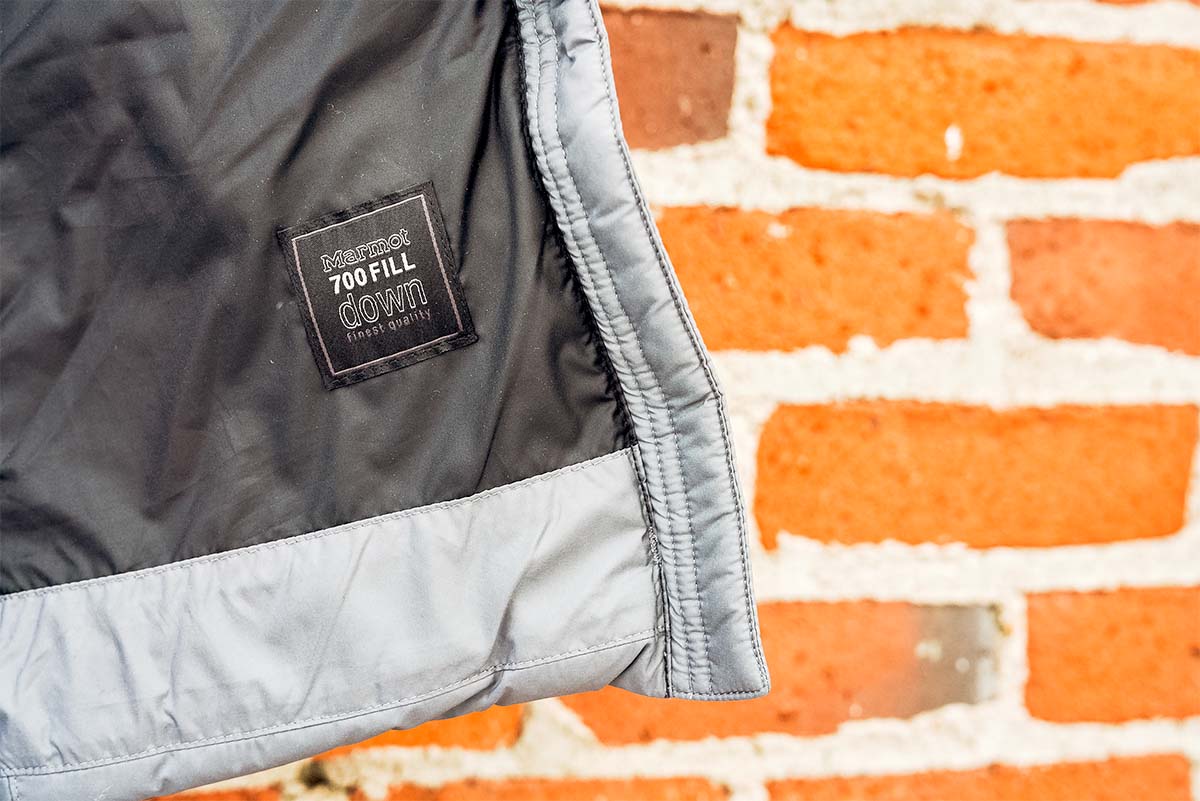
For jackets, 550- to 650-fill down is what you'll find in most entry- and mid-level models, which is perfectly respectable for daily wear but falls short for performance use. Premium down is 800-fill and above and what Arc'teryx, Patagonia, and Mountain Hardwear use for their high-end down jackets. At this level of quality, you reap the highly touted benefits of down insulation: lightweight and ultra-compressible warmth. Some high-end climbing brands like Feathered Friends and Montbell even use 900-fill down (or higher), but that high of a number is a rarity and 800-fill is considered premium.
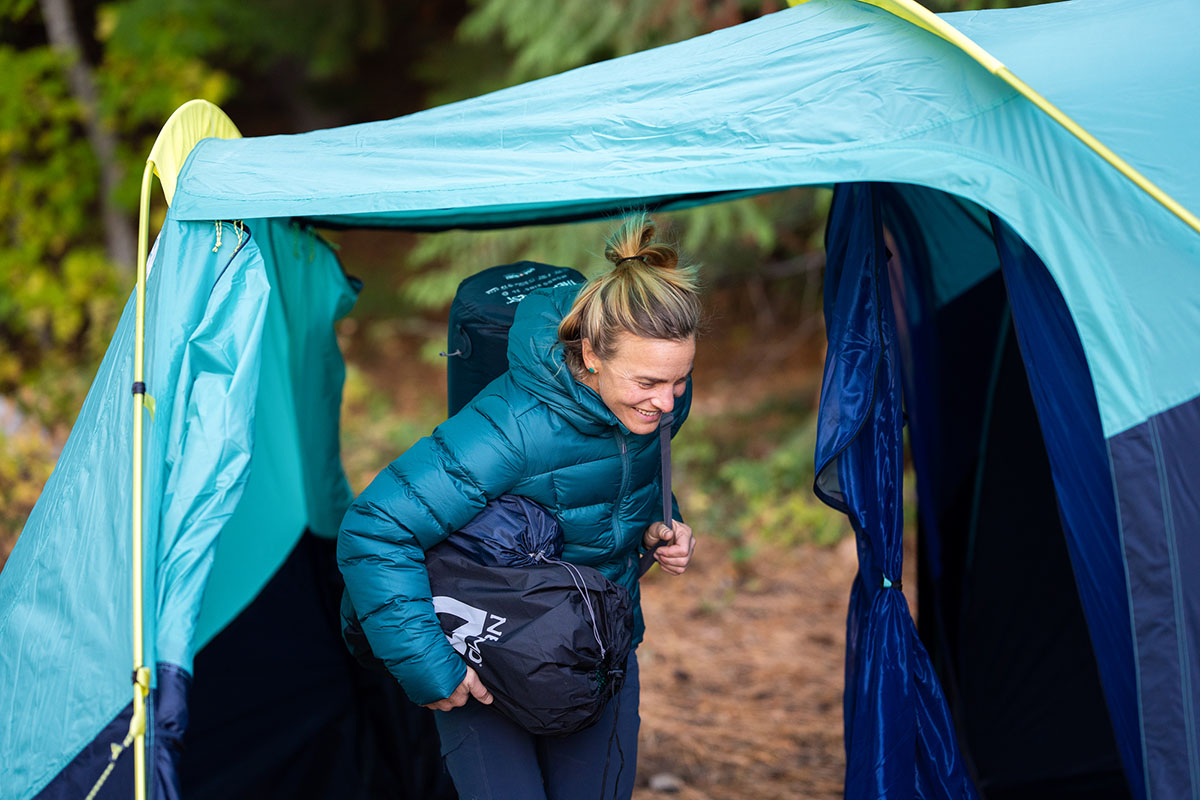
Fill Weight
Fill power gets the most press, but fill weight is equally (if not more) important in determining a down jacket's warmth. Fill weight is the actual amount of down stuffed into a jacket, measured in ounces. For example, if Jacket A has 6 ounces of 800-fill down and Jacket B has 3 ounces of 800-fill down, you can expect that Jacket A will be significantly warmer (we estimate that it would increase comfort levels in low-output activities by approximately 10-20 degrees). Lower-fill-power down offers less warmth per ounce, so in order to make an apples-to-apples comparison between jackets, it's important that they have identical (or similar) fill powers.
We find it interesting that fill weight is much less publicized than fill power, which leads to a lot of confusion for shoppers who associate higher fill power as always meaning more warmth. As a result, we sometimes have to call the manufacturers to track down fill weight as it's not always listed (for more information, see our article: Down Fill and Insulation Explained). On our list above, we've noted both the fill power and weight whenever possible so that you can make an accurate and informed choice when shopping around.
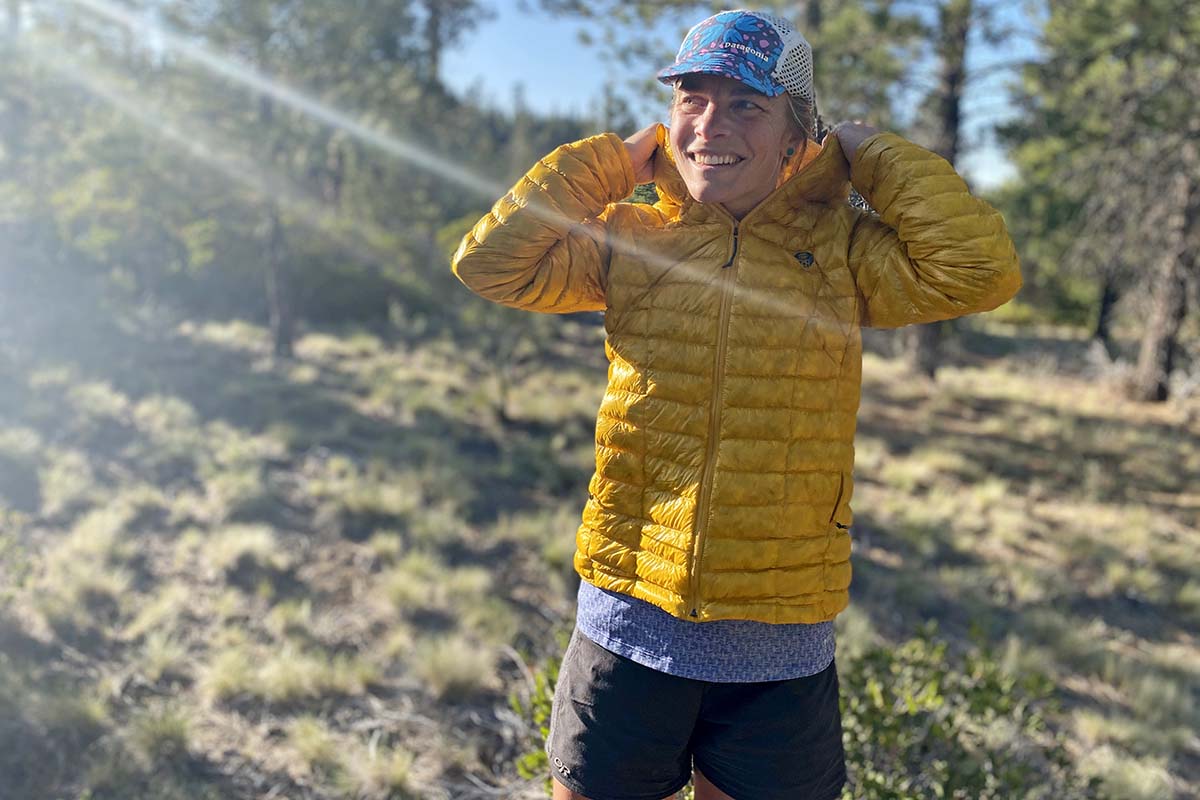
Our Estimated Temperature Scale
It's tough to pinpoint an exact temperature range in which you will feel comfortable wearing a down jacket (there's a reason no one has attempted to create a standardized rating system). Factors like fit, layering, your level of exertion and circulation, and wind all play a role. But generally, we think of ultralight and lightweight jackets (including down sweaters)—which usually have between 2 and 4 ounces of down—as providing solid warmth in conditions ranging from around 35 to 60 degrees Fahrenheit. A cozy baselayer can buy you an extra 5 to 15 degrees depending on its thickness and quality. These types of jackets are very popular for 3-season alpine use and in most U.S. cities for all but the coldest of winter days.
When the mercury drops below freezing, we recommend stepping up to a midweight or heavyweight down jacket. The fill weight of these jackets should be 4 ounces at minimum and often is in the range of 5 to 6 ounces or more. For example, the midweight Patagonia Fitz Roy and heavyweight Rab Neutrino Pro are packed with 4.5 and 7 ounces of down respectively. For bitter cold and climbing higher peaks, an even heavier performance down parka (such as Patagonia's Grade VII Down Parka and the Arc'teryx Firebee AR) may be in order.
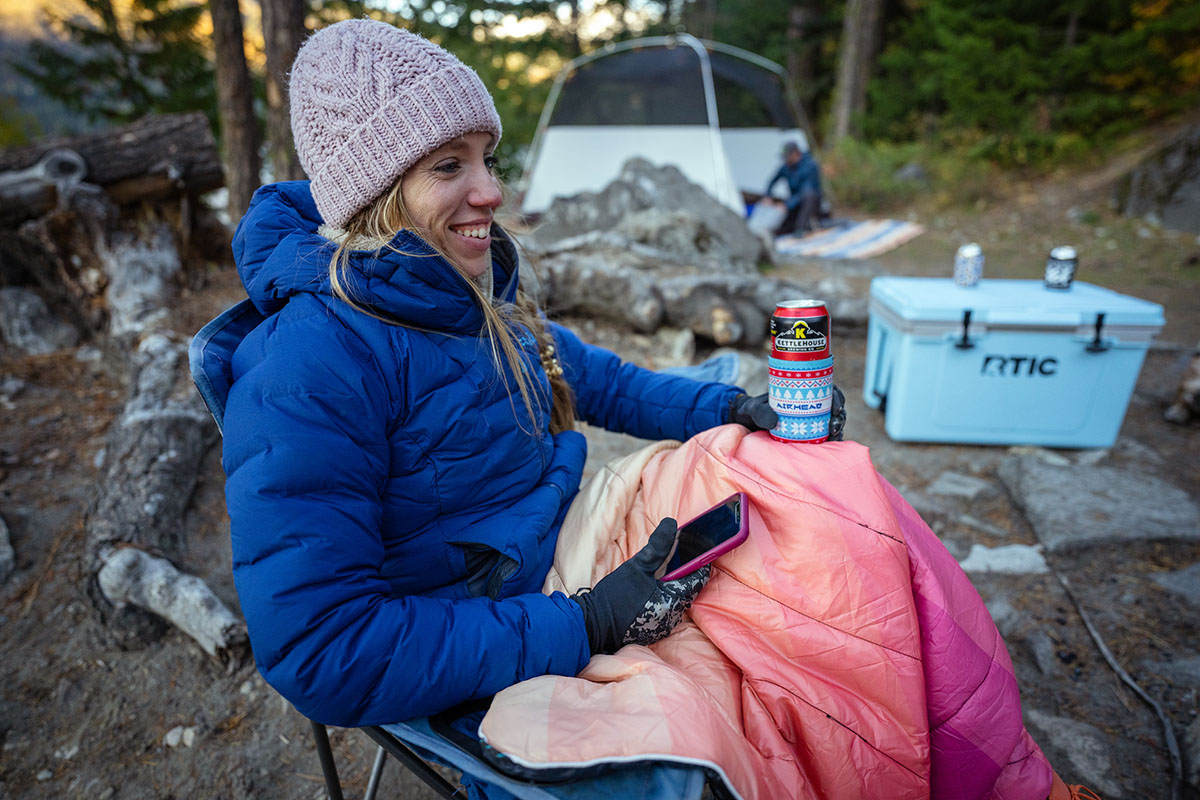
Weight
For uses like backpacking, climbing, mountaineering, ski touring—or whenever you have to lug around your own gear—the total weight of your down jacket should play a significant role in your buying decision. Jackets like the Mountain Hardwear Ghost Whisperer/2 (7.8 oz.) and Feathered Friends Eos (9.3 oz.) weigh very little for the warmth they provide and compress down extremely small in your pack. However, they also cost considerably more than your typical and more casual down sweater. On the other hand, if you need a layer for around-town and occasional outdoor uses like downhill skiing, you'll be completely fine with a somewhat heavier and more affordable build like the 14.8-ounce Arc'teryx Thorium AR. Finally, winter-ready jackets will obviously be the heaviest options, including the 1-pound-10-ounce REI Co-op Stormhenge Down Hybrid.
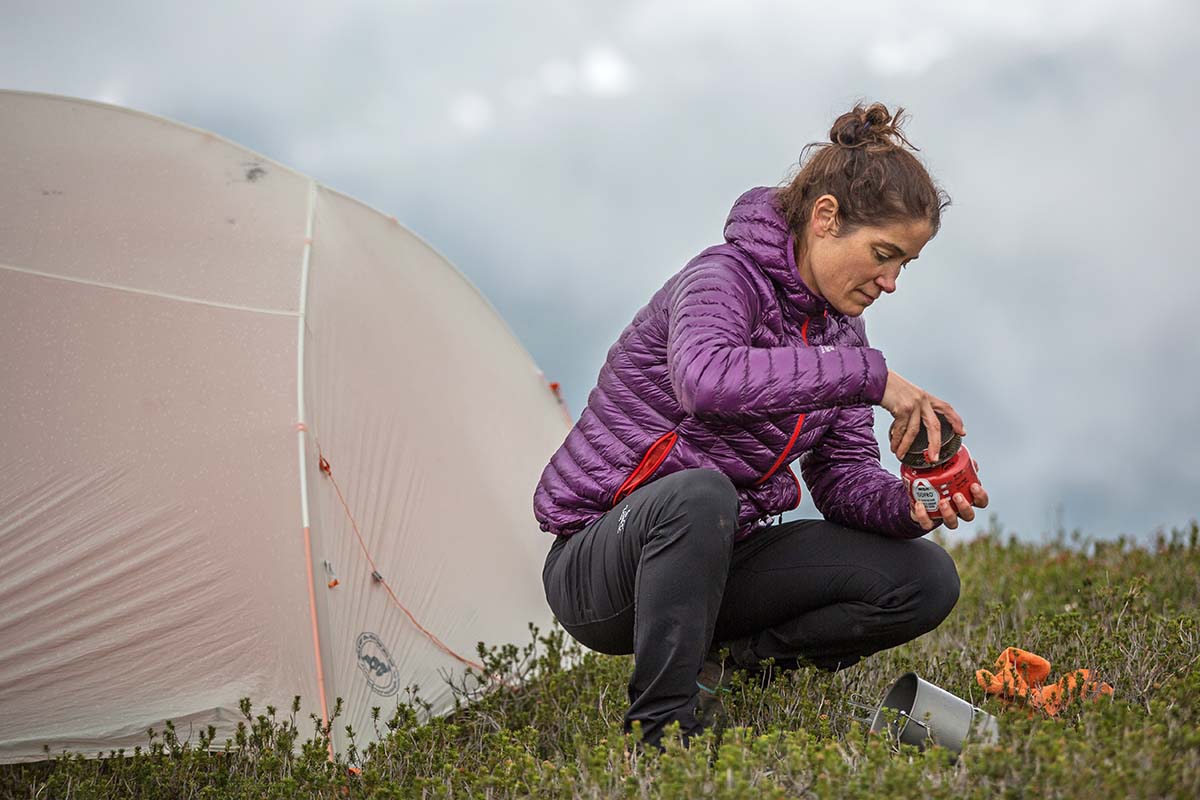
"Ultralight" is a buzzword of sorts that you will inevitably run into when shopping for a down jacket, and it's worth noting there aren't hard-and-fast rules as to what qualifies. We keep a close eye on the ratio of fill weight to total weight to see what lengths the manufacturer went to trim weight (the shell denier is a good hint too, and more on that below). At the extreme end of the spectrum is Mountain Hardwear's Ghost Whisperer UL (see our in-depth review here), which packs 1.9 ounces of down inside a superlight 6.2-ounce package. When gear companies really prioritize cutting weight, you'll see changes to zippers, a trim fit, and a lack of pockets. Some even opt for a pullover style to cut out half of the zipper. No matter what the manufacturer names a jacket, keep a close eye on fill weight and total weight to make your own determination.
Compressibility and Packed Size
Down enthusiasts love its compressibility and for good reason. An ultralight jacket like the Mountain Hardwear Ghost Whisperer/2 can be stuffed into its own pocket and end up much smaller than a Nalgene bottle. The tiny packed size means you have little reason to leave it behind and can fit it easily into either a daypack or overnight backpacking pack.
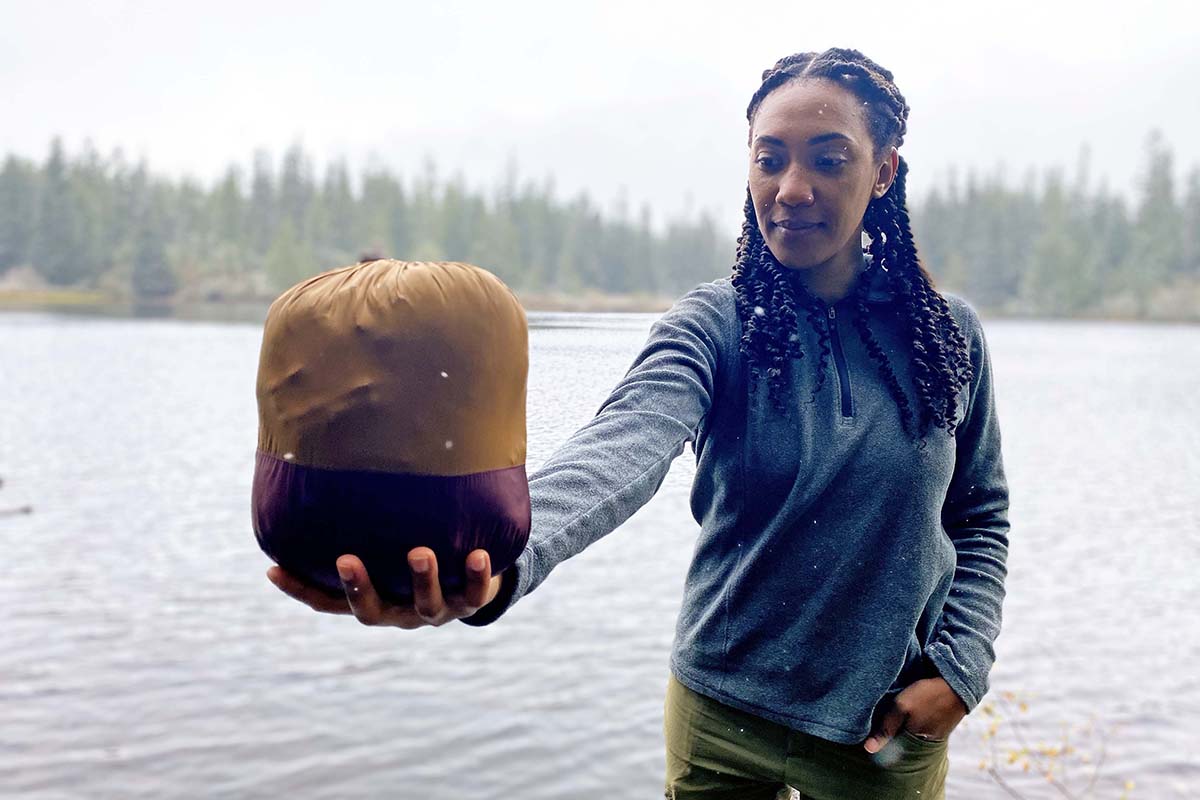
Keep in mind that the higher the fill power, the more easily your jacket will compress. This is noticeable when you get into premium levels of down (800-fill and above), which pack down to seemingly impossible sizes yet bounce back after only a few minutes out of the bag (as long as you don't store it compressed too long). Fabric thickness also plays an important role, and thinner-denier fabrics logically pack down smaller. Along with warmth for the weight, compressibility is an area where down dominates the vast majority of synthetic-insulated jackets.
Shell Fabric and Durability
As the casing that holds the all-important down, a jacket's shell fabric is a crucial component to consider. The thickness of a jacket's outer fabric is listed in denier (D), which is a measurement of the weight of a thread. The lower the denier, the thinner the fabric. Thin shells are less durable and more susceptible to tears or punctures, but they're also lighter-weight. That said, almost all of the jackets on this list are made with reasonably lightweight shell fabrics. The thinnest is the Arc'teryx Cerium LT, which has a fragile 10-denier shell, and the thickest (at least among those that report this spec) is The North Face's Gotham, which has a robust 50-denier shell. 10 denier is fairly standard for ultralight pieces, and a more substantial 20 denier is what you'll find most often in an average down sweater. Don't underestimate the impact of denier: even the difference from 10 to 20 denier can play a significant role in the total weight and potential lifespan of your jacket.
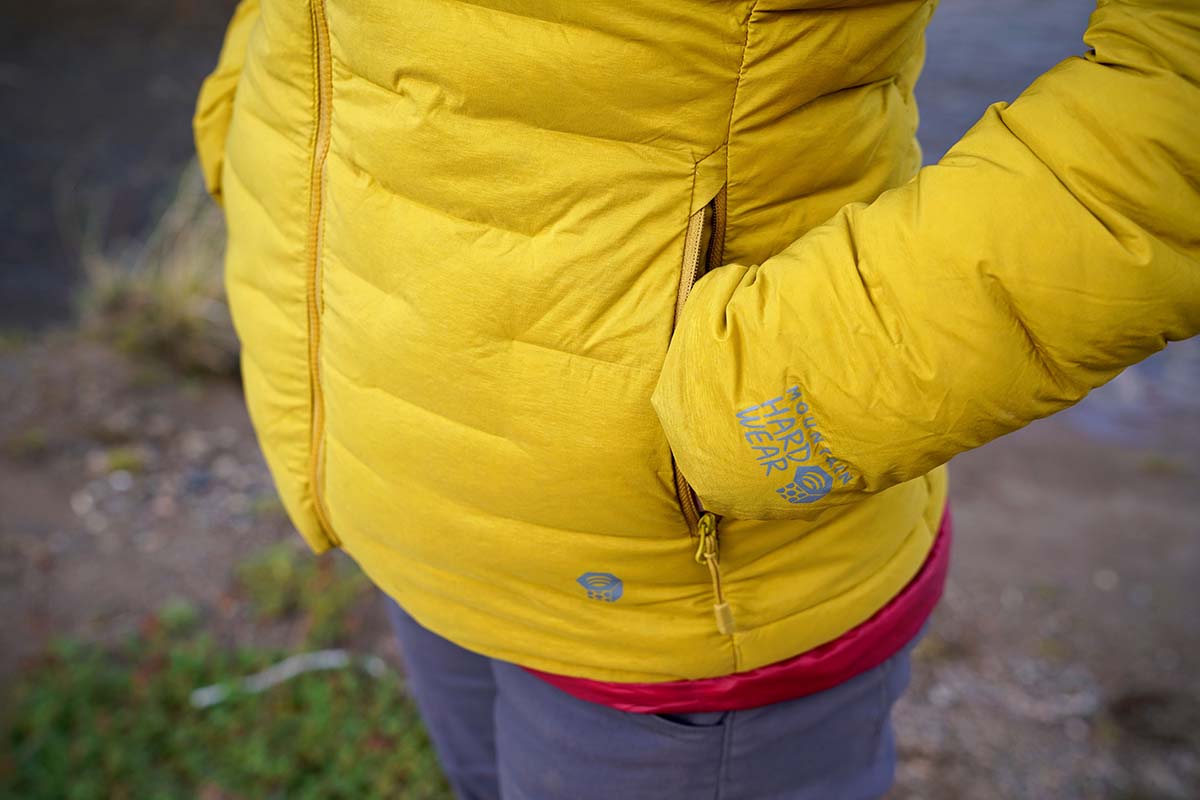
Other than denier, there are a few other factors that impact the overall durability of your jacket's shell. First, a fabric with stretch (like Mountain Hardwear's Stretchdown and Rab's Cubit Stretch Down) will have a lot more give to it, meaning it will stretch under pressure rather than rip. Very few down jackets are made with stretchy shell fabrics, but we like the brands' innovations here. The material used is another consideration. For example, we find the difference between the Rab Neutrino Pro's Pertex Quantum Pro and the Patagonia Fitz Roy's Pertex Quantum (both 20D) to be palpable (the former is much more durable). Finally, some jackets will use higher-denier fabrics in high-use areas such as the sleeves and shoulders, which can make a huge difference. To summarize: if durability is one of your top priorities, you'll want to dig a little deeper than the initial denier spec.
Hydrophobic Down and DWR Treatment
Down feathers unfortunately lose much of their ability to insulate when wet, turning into a clumpy and soggy mess. This makes them a serious liability in wet conditions or if you're sweating heavily, which is why some prefer synthetic jackets, which continue to insulate when wet. However, gear manufacturers have found a way to treat down to make it more water-resistant. They do this by adding a polymer to the down before filling the jacket, and the result is that it resists water better and you don't have to worry as much about light precipitation. Even though hydrophobic down still doesn't match the wet-weather performance of synthetics, it can be an extra line of defense. If you're headed out in a wet area like the Pacific Northwest or New Zealand, a jacket with hydrophobic down like the Rab Microlight Alpine (along with a waterproof shell) is a smart choice.
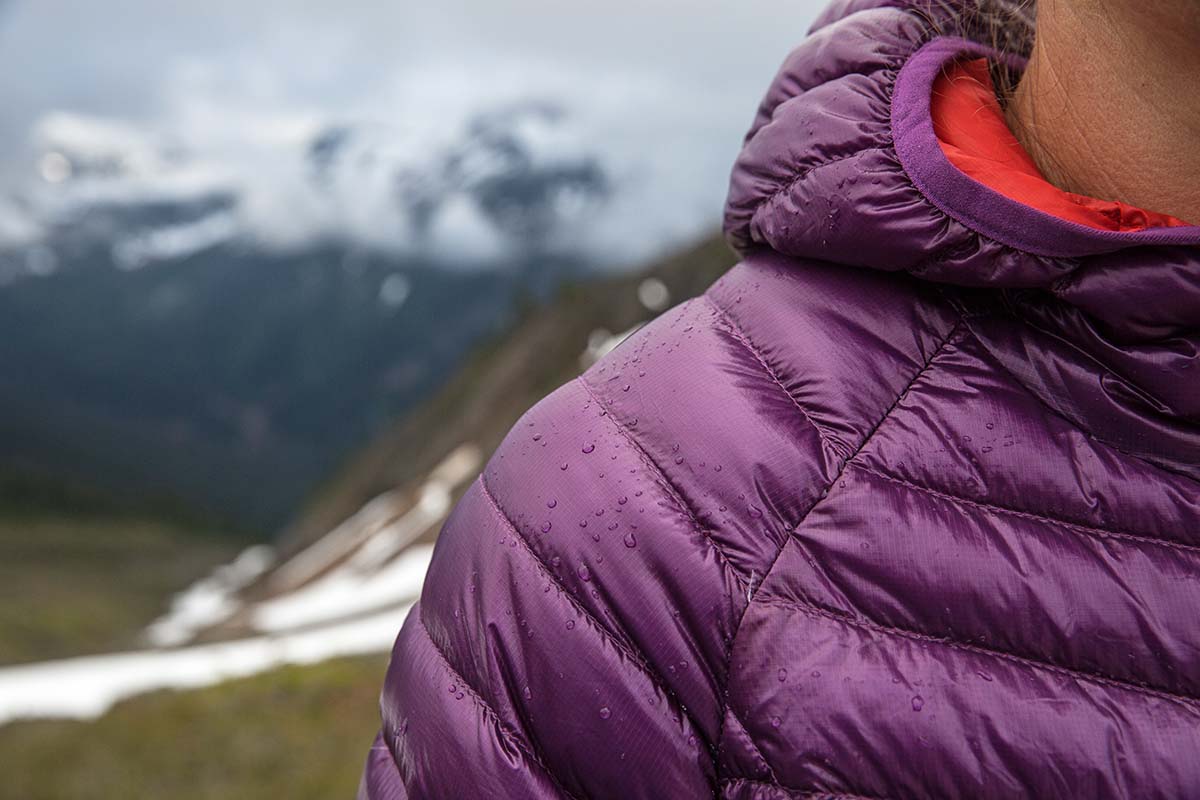
Another way that gear manufacturers fight moisture is a DWR (durable water repellant) treatment on the outside on the jacket (which we mention in the sustainability section below). This coating helps prevent water droplets from forming and entering your jacket—essentially the water has a harder time staying on the fabric and beads up and rolls off instead. Jackets like the Outdoor Research Helium Down Hoodie take this to the next level, with a waterproof shell on the shoulders and the hood. Keep in mind that none of these technologies are guaranteed to keep your down completely dry, but they do make nice lines of defense against light to moderate precipitation. For true wet weather, your best bet is a synthetic jacket, which is able to insulate even when wet.
Down Jacket Fit and Length
Fit is jacket-specific, but there are two main considerations here. First, casual jackets and down sweaters generally have a more casual fit than ultralight or performance jackets, including boxier torsos, arms, and hoods (when available). Second, fit varies significantly by brand. From our experience, Arc'teryx jackets like the Cerium LT Hoody fit the slimmest of all and are a good match for athletic folks who demand mobility from their jackets (this can also be good for layering under a shell). Mountain Equipment and Rab also err on the trimmer side, while brands like Patagonia, Outdoor Research, and Mountain Hardwear often have more accommodating shapes that balance everyday comfort with performance. And finally, we've found that REI Co-op and Columbia fall on the roomier end of the spectrum, and we occasionally need to size down (including with the REI 650 Down Jacket 2.0).
.jpg)
You'll also want to take length into account with your down jacket purchase. Simply put, a longer cut equates to more coverage and warmth, although it does have some impact on mobility. On the shorter end of the spectrum, many down sweaters and other lightweight pieces end right around the waist or hips. This is great for movement, but your legs remain uninsulated. A number of down parkas like the Marmot Montreal offer thigh-length coverage, which offers a nice boost in warmth compared to the down sweater counterparts. And models like the Patagonia Down With It Parka go all the way to the knees, which is excellent for staying cozy but can make it difficult to sit down or cover long distances walking.
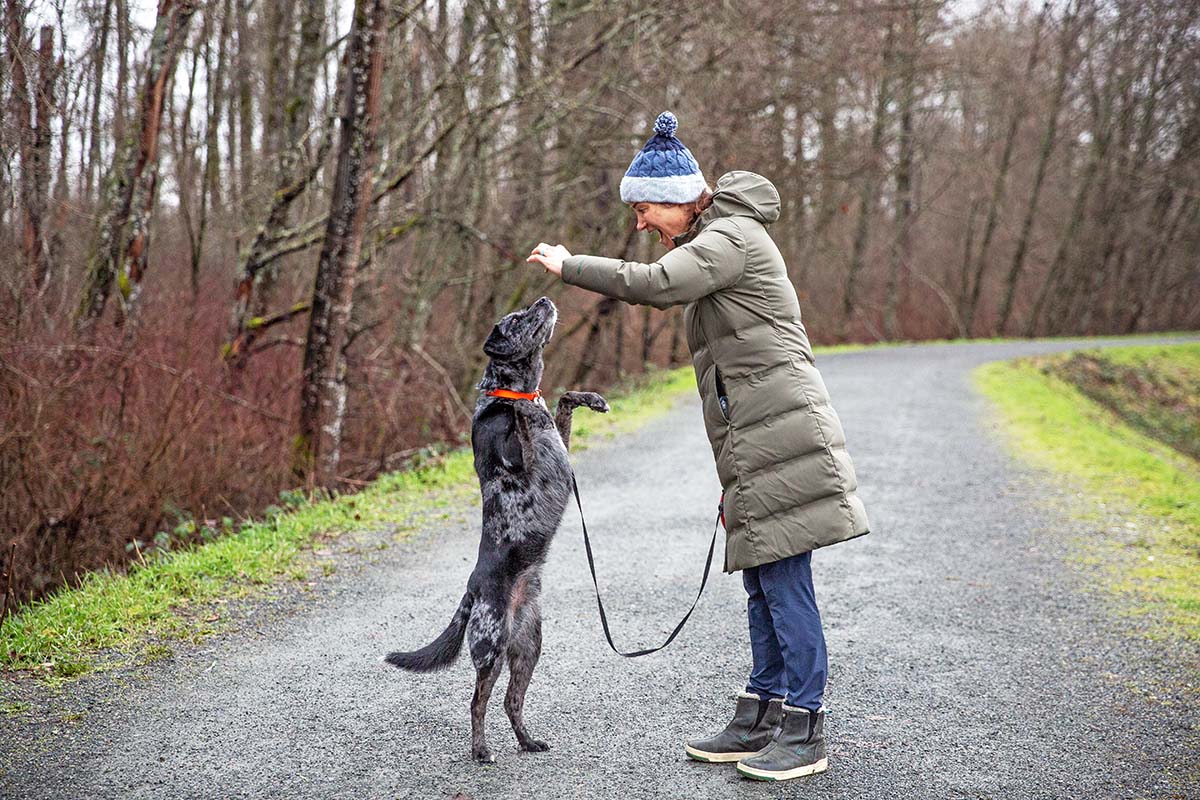
Hood or No Hood?
Most down jackets on this list are offered in hooded and non-hooded versions. The non-hooded version is slightly cheaper and weighs less, but you don't get the advantage of the extra warmth, coverage, or comfort. For casual use or as a midlayer for skiing, many go without the hood and carry a separate beanie instead. For uses like backpacking and climbing, the opposite is the case: most pay extra for a hood and don't regret it. In our picks above, we listed down sweaters in the non-hooded versions and ultralight down jackets in hooded form, which are how most people purchase them. But in the end, it all comes down to intended use and how you plan to layer for your preferred activities. For a deeper dive into the topic, see our article: Does Your Down Jacket Need a Hood?
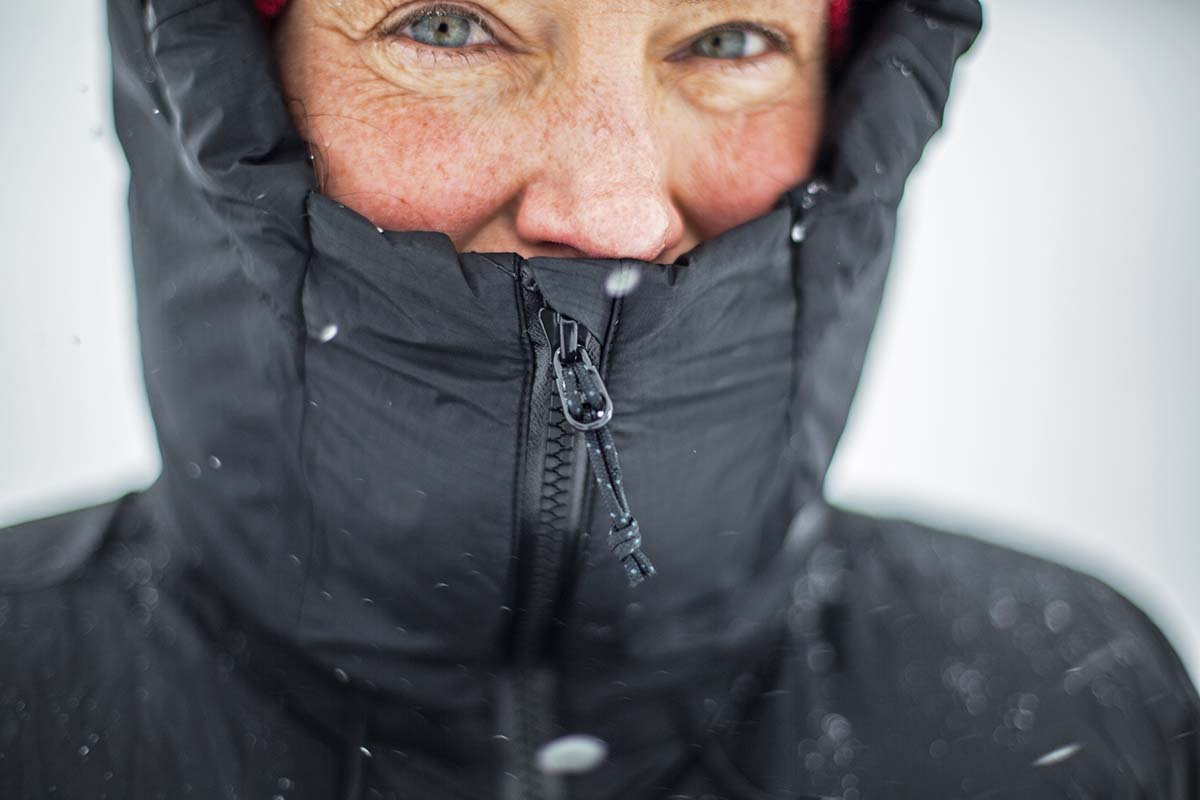
Sustainability: RDS-Certified Down, Recycled Fabrics, and PFC-Free DWR
Our impact on the environment has never been of greater concern, and it's nice to see gear companies step it up with more sustainable practices. One measure we're seeing more and more of is the use of responsibly sourced down (look for an RDS certification or, in the case of Patagonia, Advanced Global Traceable Down). In short, this translates to greater transparency in where the down comes from and ensures the birds were treated humanely and not subjected to unnecessary harm, such as force-feeding or live-plucking. In addition, the use of recycled fabrics has grown substantially in the past few years, with companies like Patagonia, REI Co-op, and Mountain Hardwear prioritizing these materials.
A final trend to touch on is the use of PFC-free durable water repellent (DWR) finishes. We detail the benefits of DWR above, but pertaining to sustainability, traditional DWRs utilize perfluorinated compounds (PFCs), which is a chemical that's been linked to a range of environmental and health issues. The good news is that some brands have started making the shift to PFC-free DWR, but it's mostly been limited to the rain jacket and hardshell markets (Marmot and Mountain Hardwear are leaders here). That said, given the current landscape, we fully expect this to be incorporated into the down jacket world in the next few years.
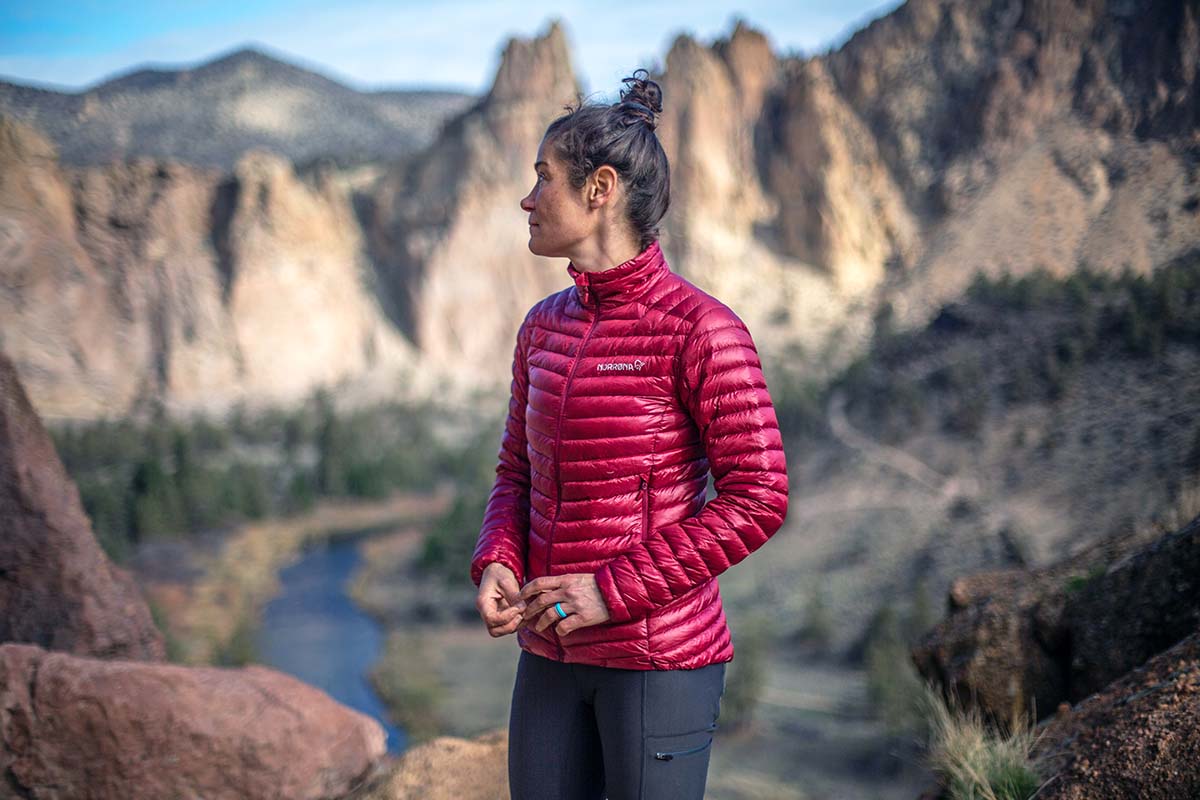
What About Synthetic Jackets?
There is a lot to be said for synthetic insulated jackets, which insulate better than down when wet, are more breathable, and generally cost considerably less. For insulation that we wear during activity (such as while climbing or backcountry skiing), we'll reach for synthetic over down nine times out of 10. However, when it comes to particularly cold weather or weight- and space-conscious pursuits (when you're carrying your jacket in your pack), down has no replacement (at least for now).
We've tested a number of synthetic jackets like the Arc'teryx Atom LT and Patagonia Micro Puff (see our in-depth review), both of which are very comfortable and reasonably light. However, the warmth-to-weight and packability just aren't the same as down options, and there's simply no substitute for the comfort that lofty plumage brings. Optimally, you would have both, but if you're only in the market for a single jacket, there's simply no better insulator than down. For a more detailed explanation of this topic, see our article on down vs. synthetic insulation.
Back to Women's Down Jacket Picks Back to Women's Down Jacket Comparison Table
matthewsgotin1978.blogspot.com
Source: https://www.switchbacktravel.com/best-womens-down-jackets
0 Response to "Patagonia Down With It Parka Womens Stone Blue"
Post a Comment